Birds have been rich in symbolism across cultures and ages, representing various symbolic and spiritual messages.
The flighty nature of the birds has been linked to the deeply ingrained human yearning for freedom, while their acute senses of sight and hearing are associated with heightened intuition, wisdom, and clarity.
In many religions, birds represent divine intervention and miraculous powers, often depicted as messengers between heaven and earth.
From the regal eagles in Native American culture to the peaceful doves in Christianity, and the exotic phoenix bird in the mythology of the Far East, birds have been celebrated in myths, legends, stories, and art.
We’ll find the symbolic meanings and cultural significance of birds in human history.
1. Cranes
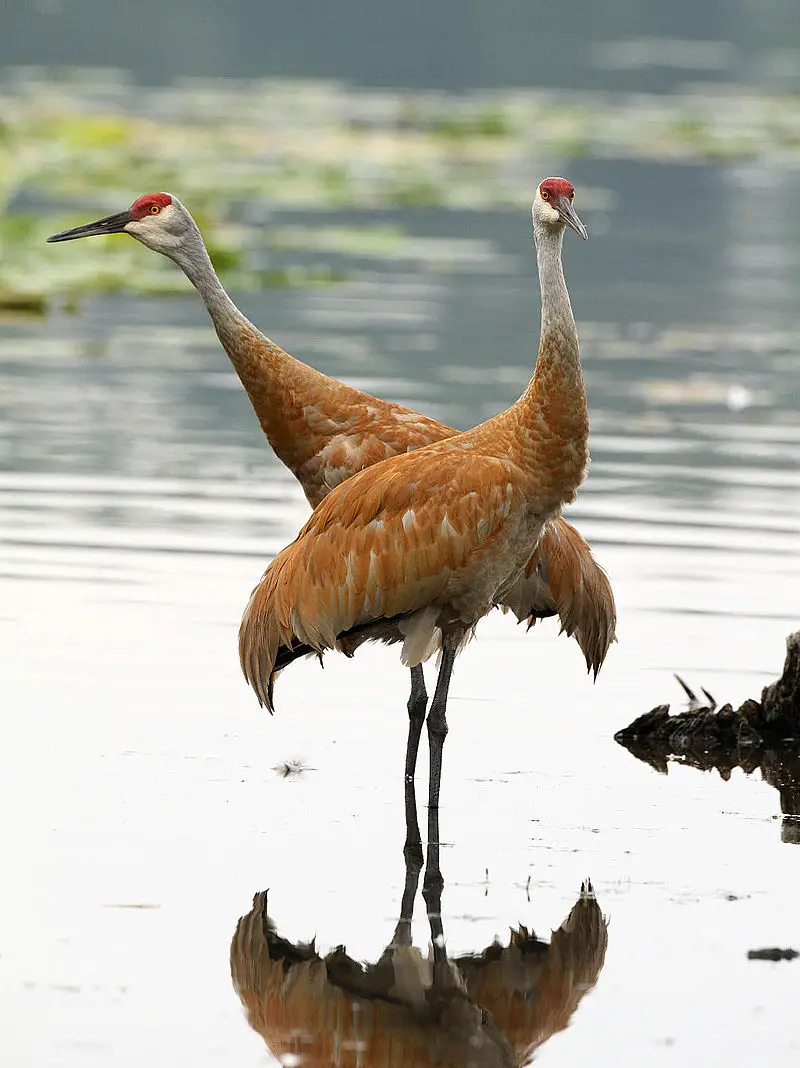
Cranes are majestic birds that can be found on most continents except Antarctica and South America. They are in the Gruiformes group of birds and belong to the family Gruidae.
Cranes have long legs, and long necks, and stand out from other birds due to their impressive size.
When they fly, they do so with their necks outstretched rather than pulled back like many other similar-looking species like herons.
There are fifteen species of cranes that are divided into three genera: Antigone, Balearica, and Grus.
They are a sight to behold and are sure to leave a lasting impression on anyone lucky enough to observe them in their natural habitat.Scientific classification:
| Kingdom | Animalia |
| Phylum | Chordata |
| Class | Aves |
| Order | Gruiformes |
| Superfamily | Gruoidea |
| Family | GruidaeVigors, 1825 |
Also Featured In: Most Common Birds in China, Flocks Birds around Us
2. Mandarin Duck
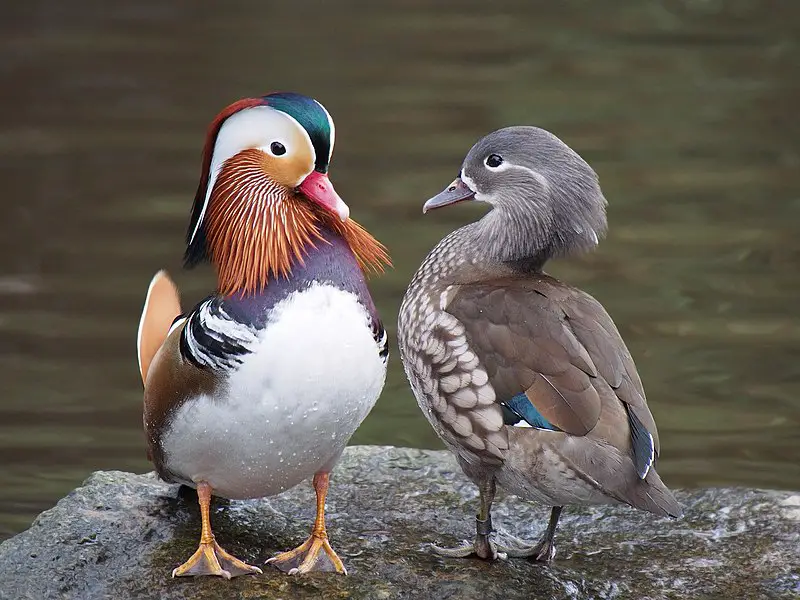
The Mandarin Duck is a stunningly beautiful bird native to the East Palearctic region. It has striking plumage, with the males featuring brightly-colored feathers of purple, blue, and green on their head, back, and wings as well as an orange bill.
The females are duller in color but still have attractive markings. They measure between 16 and 19 inches long with a wing span of 26 to 30 inches wide.
These ducks prefer freshwater habitats like lakes or rivers but will also forage for food in nearby grasslands or wooded areas if needed.
During the breeding season, they form pairs that nest either high up in trees near water sources or more commonly next to reeds close by ponds where they lay around 10 eggs at once.
After hatching their young remain together until autumn when they begin migrating southwards towards wintering grounds further away from their northern homes.
However, some individuals can stay put depending on local climate conditions and availability of resources such as food supply during colder months of the year before returning north.
They again come springtime when temperatures rise again allowing them easier access to aquatic vegetation that sustains them throughout the summer months ahead then repeat this cycle each year thereafter.Scientific classification:
| Kingdom | Animalia |
| Phylum | Chordata |
| Class | Aves |
| Order | Anseriformes |
| Family | Anatidae |
| Genus | Aix |
| Species | A. galericulata |
Also Featured In: Most Common Birds of Ko Samui,
3. Red-Crowned Crane
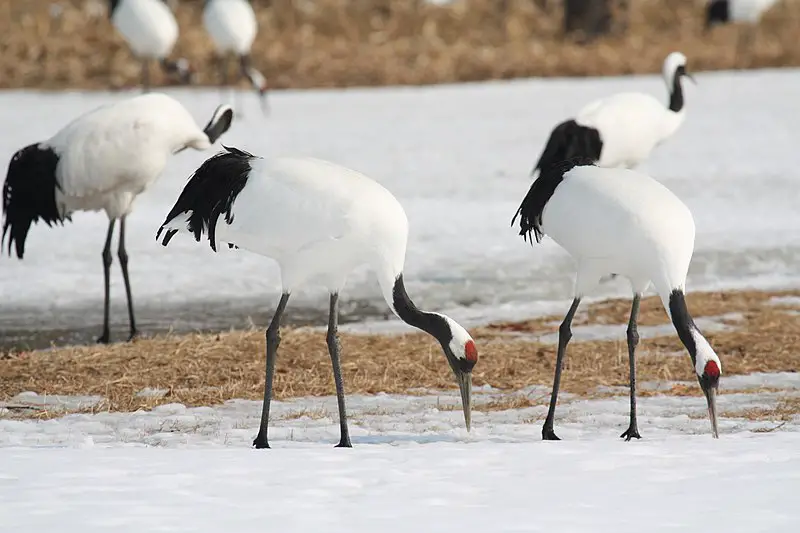
The Red-crowned Crane, also known as the Manchurian or Japanese crane, is a rare and majestic East Asian bird. It has striking red feathers on its head which give it an elegant crown look.
These cranes are large and can be seen in some parts of their range flying gracefully with slow wing beats. When they land to rest you may hear them making loud calls that carry across wide distances.
Not only do these birds have beautiful plumage but they also hold spiritual significance for many cultures throughout Asia where they are considered symbols of luck, loyalty and longevity.
With conservation efforts increasing more people will get to experience this amazing species.Scientific classification:
| Kingdom | Animalia |
| Phylum | Chordata |
| Class | Aves |
| Order | Gruiformes |
| Family | Gruidae |
| Genus | Grus |
| Species | G. japonensis |
Also Featured In: Birds You’ll Find in Hokkaido,
4. Indian Peafowl
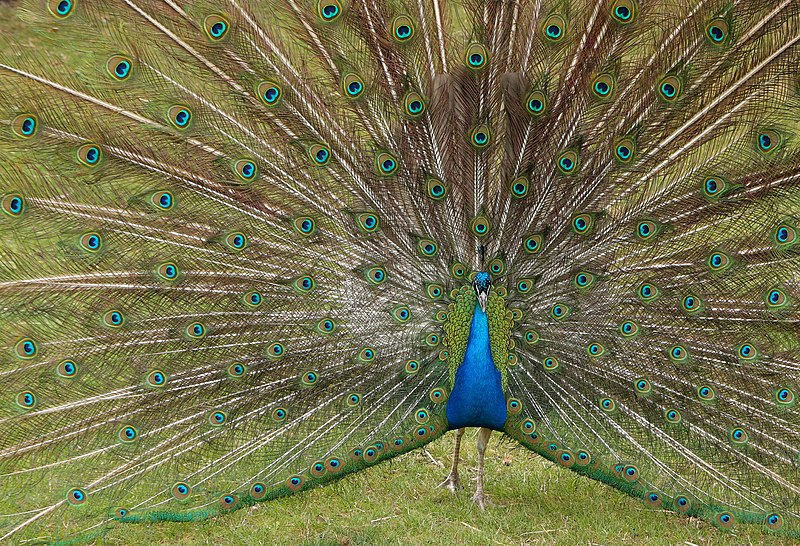
The Indian Peafowl, also known as the common peafowl or blue peafowl, is a species native to the Indian subcontinent. It has since been introduced to many other countries around the world.
Males are referred to as peacocks and females are called peahens, although both sexes can be colloquially referred to simply as “peacock”.
These birds have an impressive display of sex-specific differences in colouration; males show off their iridescent feathers in shades of green and blues while female plumage tends towards more muted browns with red accents on their tail feathers.
The mating dance performed by male Peacocks serves not only for courtship but also acts as a form of territorial advertisement between rival males over available resources such as food sources.
This colourful bird lives up its name with its beautiful displays that captivate viewers from all walks of life.Scientific classification:
| Kingdom | Animalia |
| Phylum | Chordata |
| Class | Aves |
| Order | Galliformes |
| Family | Phasianidae |
| Genus | Pavo |
| Species | P. cristatus |
Also Featured In: Common Birds in India, Blue Birds You’ll Found around Us
5. Kingfisher
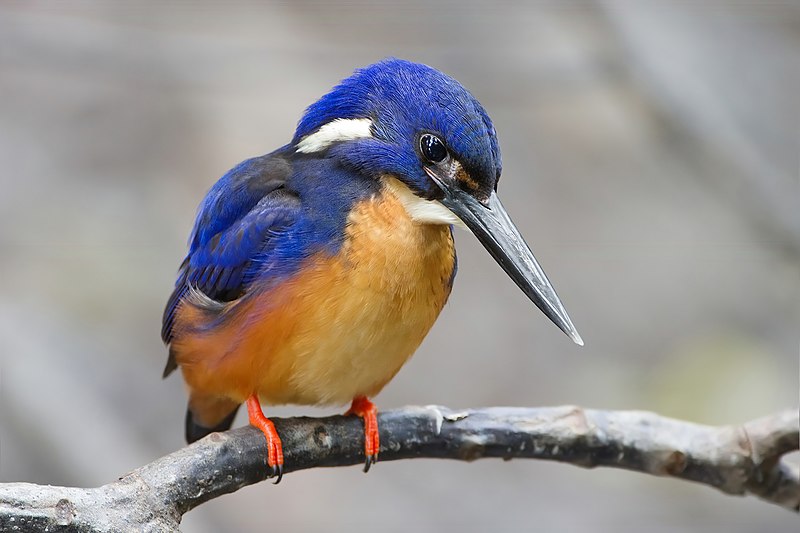
Kingfishers are a vibrant and unique family of birds, with most species found in tropical regions across Africa, Asia, Oceania and Europe.
Their bright colors make them easily identifiable among the foliage of deep forests near calm ponds or rivers.
They come in three subfamilies: tree kingfishers (Halcyoninae), water kingfishers (Cerylinae) and river kingfishers (Alcedinidae).
Kingfisher birds have short legs used for perching along branches overhanging streams or lakes; they also possess strong beaks perfect for catching fish.
These little hunters will remain motionless as if suspended from thin air until an unsuspecting prey comes within reach.
Then they swoop down quickly to grab their meal. With 116 different species making up this incredible family, there’s something special about every single one.Scientific classification:
| Kingdom | Animalia |
| Phylum | Chordata |
| Class | Aves |
| Order | Coraciiformes |
| Suborder | Alcedines |
| Family | Alcedinidae Rafinesque, 1815 |
Also Featured In: Birds You’ll Find in Moldova, Most Common Lake Birds
6. Northern Cardinal

The Northern Cardinal is a beautiful bird, easily identified by its bright red plumage. It can be found in the eastern United States from Maine to Minnesota and south through Mexico and Belize.
Along with its striking colouration, it has a distinctive crest on its head and sharp black facial markings around the eyes.
Despite their small size (measuring 7-9 inches) they are very vocal birds – males sing persistently throughout springtime to attract mates or proclaim their territory.
They typically feed on insects, seeds and fruits but also enjoy suet at backyard bird feeders.
The female is less brightly coloured than her mate but still stands out among other songbirds due to her warm brownish-red feathers.
Cardinals pair for life so you may often see them together in your garden or neighbourhood park.Scientific classification:
| Kingdom | Animalia |
| Phylum | Chordata |
| Class | Aves |
| Order | Passeriformes |
| Family | Cardinalidae |
| Genus | Cardinalis |
| Species | C. cardinalis |
Also Featured In: Most Common United States Birds, Birds Commonly Found in New York
7. American Robin

The American robin is a migratory bird, belonging to the true thrush genus and Turdidae family.
It was named after its European counterpart due to the similar reddish-orange breast they both possess; however, they are not related closely.
This species can be seen through most of North America during winter months, as well as in parts of Mexico and Central America where it also breeds.
They have plump bodies with gray upperparts and white underparts that vary from yellow on their throats down to orange toward their bellies.
Robins feed on fruits such as berries or insects like worms which makes them an important part of ecosystems by helping disperse seeds naturally throughout these areas.Scientific classification:
| Kingdom | Animalia |
| Phylum | Chordata |
| Class | Aves |
| Order | Passeriformes |
| Family | Turdidae |
| Genus | Turdus |
| Species | T. migratorius |
Also Featured In: Birds That Live in Colorado, Birds Live in Arkansas
8. American Goldfinch
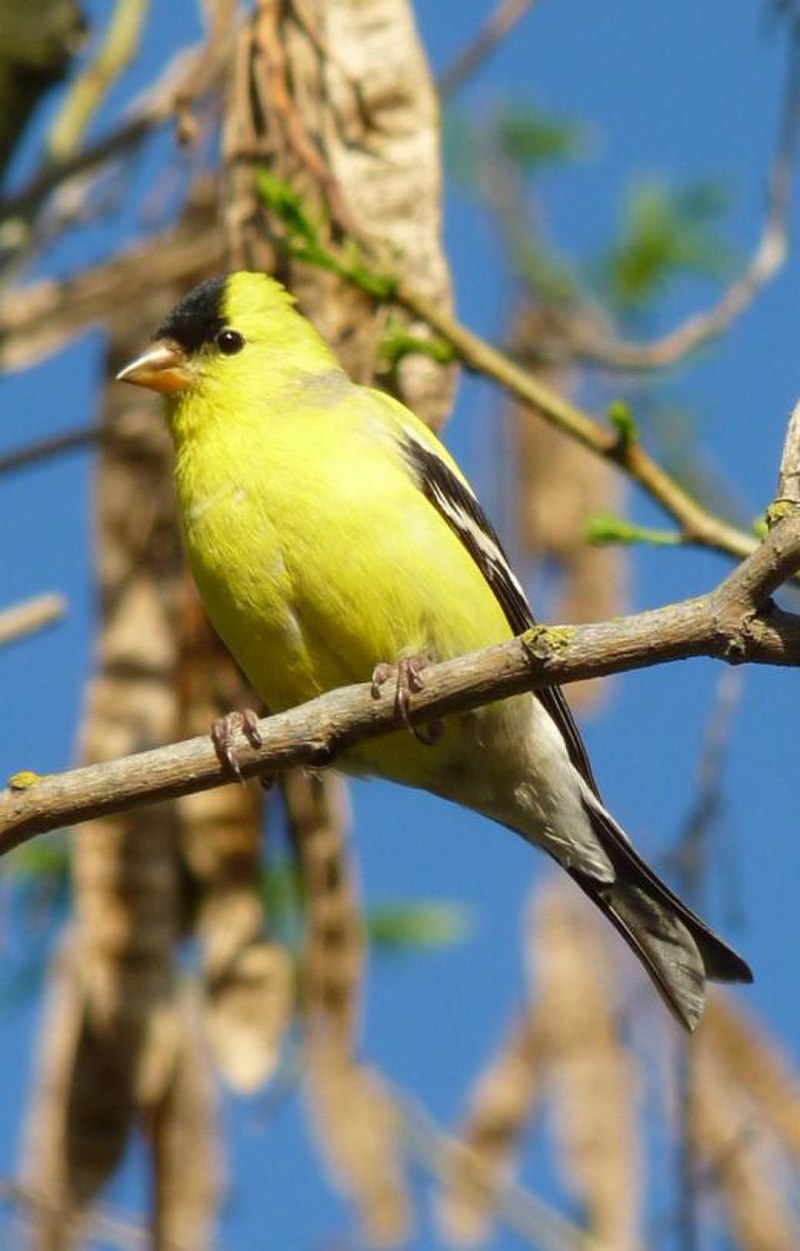
The American goldfinch is a small North American bird in the finch family. Males are vibrant yellow with black wings and tail, while females are duller in colouration.
It migrates from mid-Alberta to North Carolina during breeding season, south of Canada–United States border to Mexico for its wintering grounds.
The only finch which undergoes complete molt every year, it displays sexual dichromatism where males have brighter colours than their female counterparts.
They feed mainly on seeds but also eat insects such as aphids and caterpillars when raising youngs; they often occur near thistles or other plants that produce viable seed heads.
Their call consists of an array of chirps and trills making them quite conspicuous.Scientific classification:
| Kingdom | Animalia |
| Phylum | Chordata |
| Class | Aves |
| Order | Passeriformes |
| Family | Fringillidae |
| Subfamily | Carduelinae |
| Genus | Spinus |
| Species | S. tristis |
Also Featured In: New Hampshire Birds You Should Know, Common Southern Californian Birds
9. Songbirds
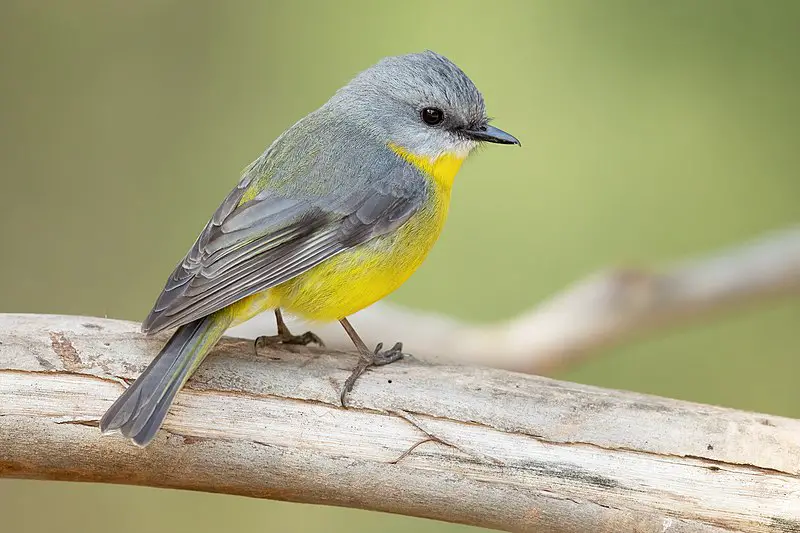
Songbirds are a special suborder of perching birds found all over the world. These beautiful creatures have intricate vocal organs that allow them to produce elaborate bird songs, making them stand out from other species.
With around 5,000 different types of songbird in existence, they come in various sizes and colors with complex feathers adding to their beauty.
Songbirds play an important role in eco-systems as they help disperse seeds by eating fruit and insects which act as agents for pollination.
Their presence also serves to attract more biodiversity into areas where these delicate animals live, creating vibrant habitats full of life.Scientific classification:
| Kingdom | Animalia |
| Phylum | Chordata |
| Class | Aves |
| Order | Passeriformes |
| Clade | Eupasseres |
| Suborder | Passeri Linnaeus, 1758 |
Also Featured In: Common Birds in the Cities, Summer Birds that Live around Us
10. Bluebirds
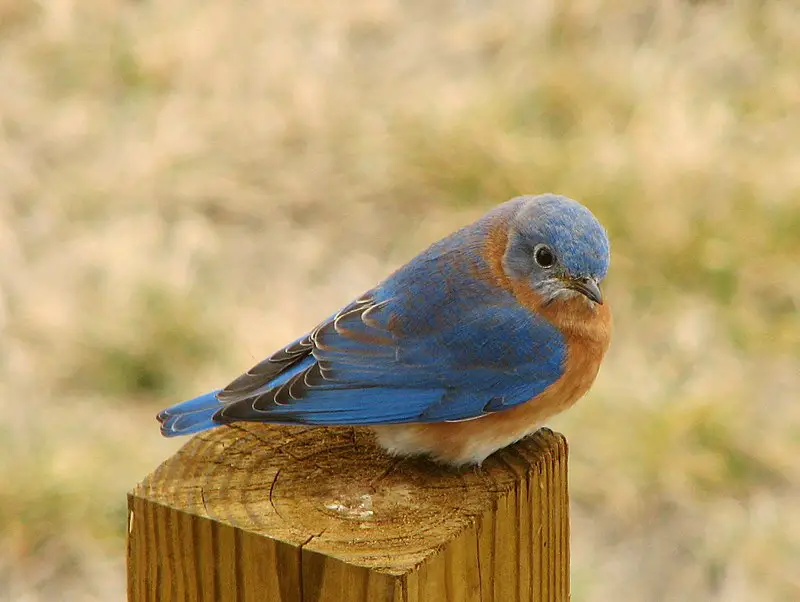
Bluebirds are a North American species of small to medium-sized birds belonging to the thrush family. They have stunning blue and rose beige plumage, with males having brighter colors than females.
These beautiful birds mainly feed on insects, but they can also eat some fruits or seeds from time to time. Bluebirds reside in open fields, meadows and backyards across much of North America.
Their cheerful songs bring joy as they fly through their habitats looking for food during the day before returning home at nightfall.
The sight of these beautiful creatures is often associated with happiness and hope – making them beloved by many people.Scientific classification:
| Kingdom | Animalia |
| Phylum | Chordata |
| Class | Aves |
| Order | Passeriformes |
| Family | Turdidae |
| Subfamily | Myadestinae |
| Genus | Sialia Swainson, 1827 |
Also Featured In: House Birds You’ll Love to Pet, Spiritual Birds
11. Wrens
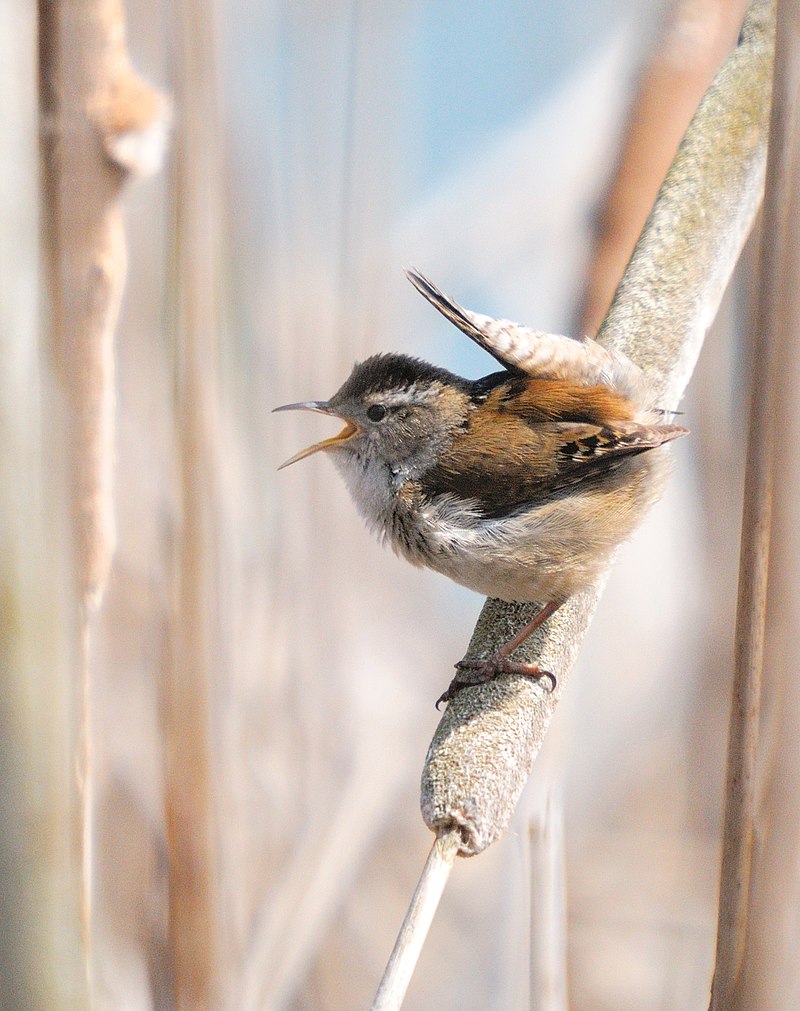
Wrens are a family of small brown passerine birds found mainly in the Americas. They are considered one of the most abundant bird species, with 88 known varieties divided into 19 genera.
The Eurasian wren is the only type that inhabits Europe and other parts of the Old World, where it’s commonly referred to simply as “wren.”
This species has been given its name due to similar-looking unrelated birds living elsewhere such as New Zealand wrasses.
Wrens have tiny bodies with thin bills and long tails which they often hold upright for hours at a time while singing their loud cheery songs from treetops or low shrubs.
Their diet consists mostly of insects but can also include fruits and seeds depending on availability in their habitat range.Scientific classification:
| Kingdom | Animalia |
| Phylum | Chordata |
| Class | Aves |
| Order | Passeriformes |
| Superfamily | Certhioidea |
| Family | Troglodytidae Swainson, 1832 |
Also Featured In: Common Denmark Birds, Most Common Scotland Birds
12. Blue Jay

The Blue Jay is a beautiful bird that resides in eastern and central United States, as well as Newfoundland Canada.
They have an unmistakable blue colored plumage with white markings on their heads and wings.
These birds are highly adaptable to different habitats ranging from deciduous forests to urban areas.
As part of the Corvidae family, they are known for being intelligent problem solvers who will often use tools or mimic vocalizations of other species like hawks when defending their territories.
Their diet consists mostly of insects, seeds and nuts but can also include small vertebrates such as frogs or lizards if food resources become scarce.
Overall these birds provide much needed color to our environment while playing important roles in maintaining healthy ecosystems through pollination services and seed dispersal activities.Scientific classification:
| Kingdom | Animalia |
| Phylum | Chordata |
| Class | Aves |
| Order | Passeriformes |
| Family | Corvidae |
| Genus | Cyanocitta |
| Species | C. cristata |
Also Featured In: Autumn Birds You Should Know, Birds that Migrate through Illinois in the Spring
13. Wild Turkey
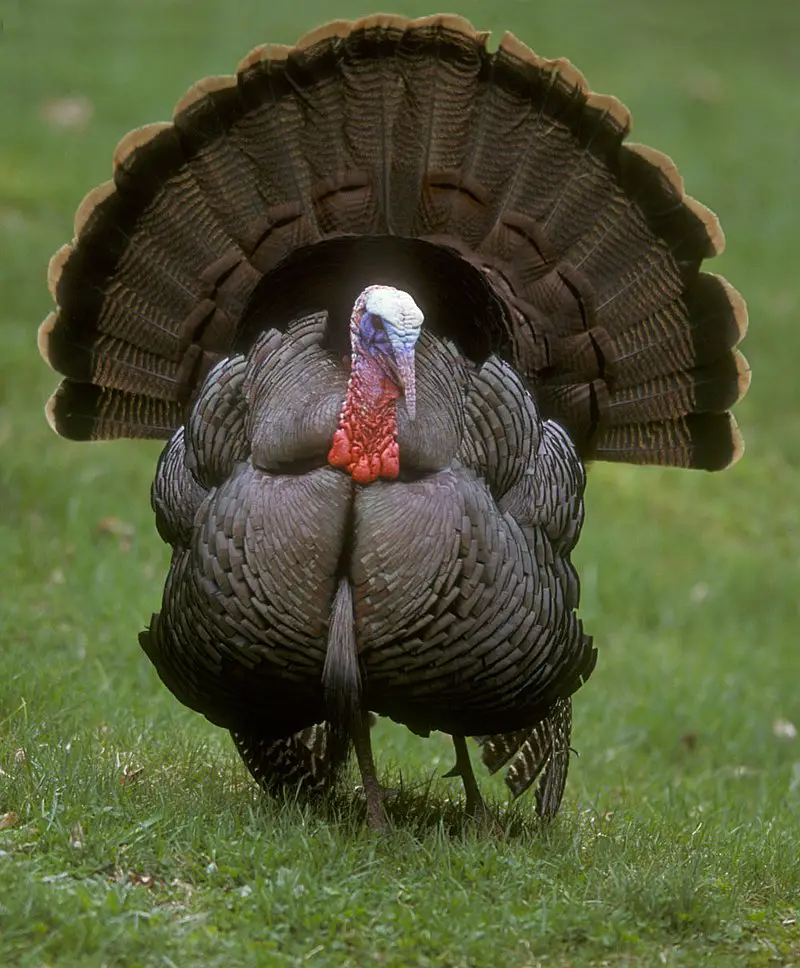
Wild turkeys are large birds native to North America, and the heaviest members of the Galliformes order.
They have long reddish-yellow legs with grayish-green feathers which distinguish them from their domesticated cousin.
Their population has been steadily increasing due to conservation efforts since being declared endangered in 1975.
Wild turkeys can be found across forests, meadows and open woodlands where they feed on insects, plant materials and small animals such as lizards or frogs.
As opportunistic omnivores they also take advantage of human food sources when available making them a familiar sight around campgrounds and picnic areas during summer months.
These majestic creatures often roost in trees at night for protection against predators but will fly off into flocks if disturbed by humans or other nearby threats .Scientific classification:
| Kingdom | Animalia |
| Phylum | Chordata |
| Class | Aves |
| Order | Galliformes |
| Family | Phasianidae |
| Genus | Meleagris |
| Species | M. gallopavo |
Also Featured In: Turkey Birds You Should Know, Common Species of Birds
14. Bald Eagle
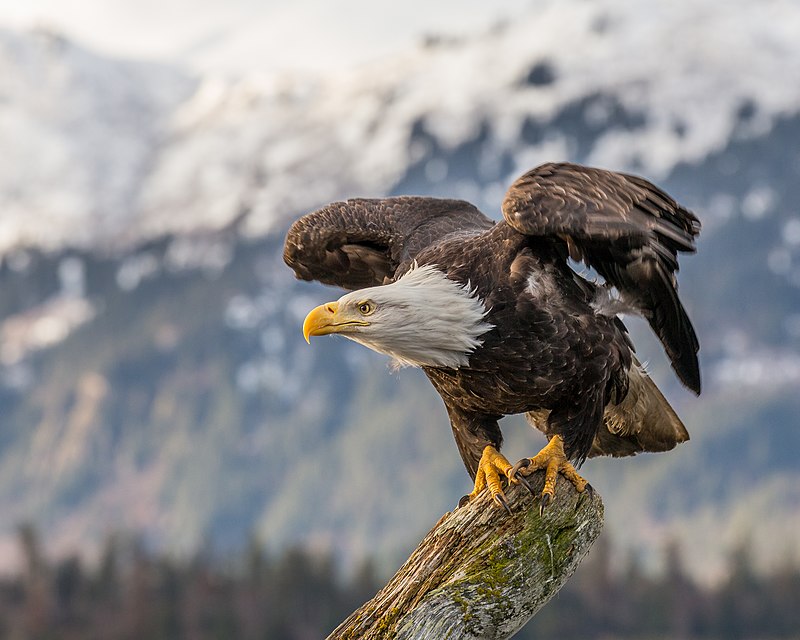
The majestic Bald Eagle is a bird of prey found in North America and recognized as the national symbol of the United States.
With its distinctive white head, brown body and striking yellow beak, this sea eagle has two known subspecies that form a species pair with the White-tailed Eagle.
It inhabits much of Canada, Alaska all states in the US contiguous area and Northern Mexico near large bodies of water where they feed mainly on fish.
These birds have an impressive wingspan ranging from 1.8 to 2 meters depending on their size making them one of nature’s most magnificent creatures.Scientific classification:
| Kingdom | Animalia |
| Phylum | Chordata |
| Class | Aves |
| Order | Accipitriformes |
| Family | Accipitridae |
| Genus | Haliaeetus |
| Species | H. leucocephalus |
Also Featured In: Everglades Birds, Birds that Found in the Yellowstone
15. House Sparrow

The house sparrow is a small bird of the Passeridae family. It has an average length of 16 cm and weighs 24-39.5 gm.
Females have dull brown and grey plumage, whereas males are brighter, with black, white and brown markings on their wings and back feathers.
This species is one among 25 different kinds in its genus Passer .These birds are found all around the world mainly near human dwellings where they feed off food scraps from garbage bins or gardens etc..
They also make nests close to houses which makes them even more visible to people living nearby.
House sparrows can be seen hopping around yards looking for food during daytime hours but usually hide in colonies at night time.Scientific classification:
| Kingdom | Animalia |
| Phylum | Chordata |
| Class | Aves |
| Order | Passeriformes |
| Family | Passeridae |
| Genus | Passer |
| Species | P. domesticus |
Also Featured In: European Birds, British Columbian Birds
16. Mourning Dove
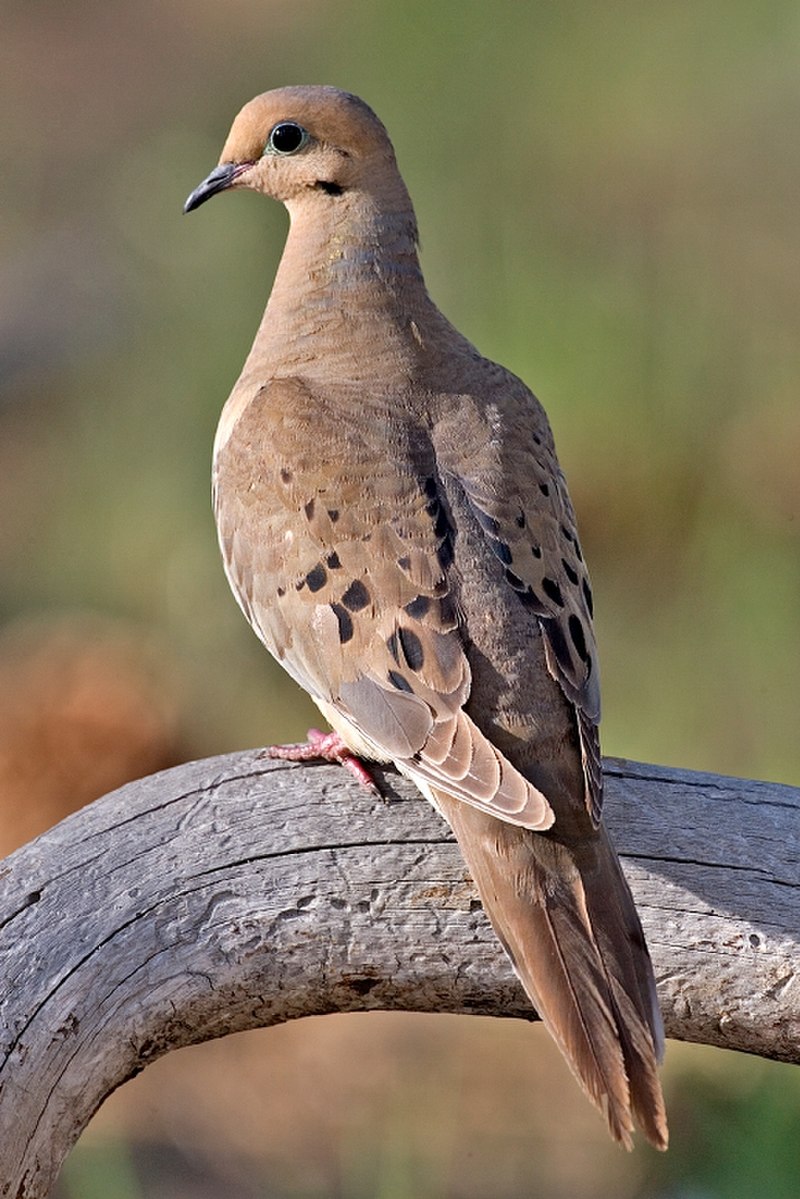
The Mourning Dove is a breathtakingly beautiful bird. It has stunning gray and brown feathers with white tipped wings, giving it an elegant appearance. Its long tail also adds to its graceful look in flight.
A symbol of peace and serenity, they are abundant across North America and can be found in gardens or open fields throughout the year.
As well as being popular game birds for hunters, they feed on grains such as wheat and millet providing important food sources for wildlife species including foxes, coyotes, skunks and raccoons.
These doves have a distinctive cooing sound that can often be heard echoing through woodlands during summer evenings making them one of nature’s greatest treasures.Scientific classification:
| Kingdom | Animalia |
| Phylum | Chordata |
| Class | Aves |
| Order | Columbiformes |
| Family | Columbidae |
| Genus | Zenaida |
| Species | Z. macroura |
Also Featured In: Birds Live Near San Diego, Common Birds That Live in Las Vegas
17. Hummingbirds
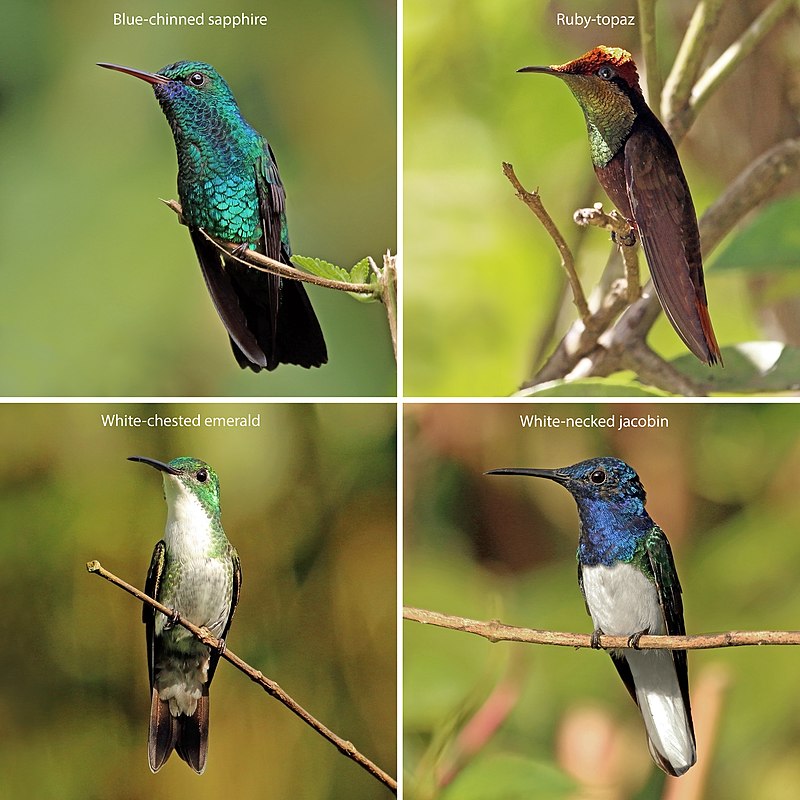
Hummingbirds are tiny birds found throughout the Americas, from Alaska to Tierra del Fuego. Most species measure between 3-5 inches in length and weigh less than an ounce.
The smallest hummingbird is only 2 inches long. Hummingbirds have a unique ability of hovering by rapidly flapping their wings up to 80 times per second.
They feed on nectar and insects, with some species even able to drink sap or eat pollen directly off flowers.
Their vibrant colors make them instantly recognizable as they dart through gardens in search of food and mates.
Hummingbirds truly bring joy into our lives as they remind us that nature’s beauty can be seen around every corner if we take the time to look for it.Scientific classification:
| Kingdom | Animalia |
| Phylum | Chordata |
| Class | Aves |
| Order | Apodiformes |
| Family | Trochilidae Vigors, 1825 |
Also Featured In: Rainforest Birds You Should Know, Spring Birds that Live around Us
18. Barn Swallow
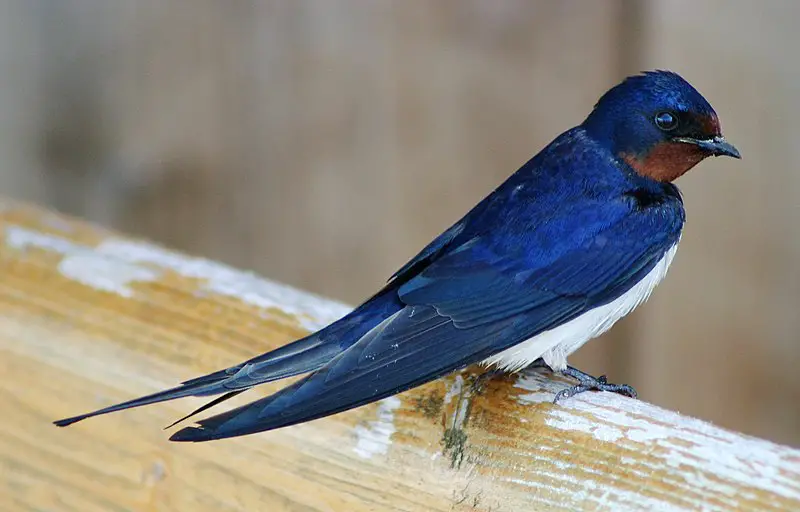
The Barn Swallow is a beautiful passerine bird with blue upperparts and a long, deeply forked tail. Found in Europe, Asia, Africa and the Americas.
It has an astonishingly large natural distribution spanning 251 million square kilometres globally; likely making it one of the world’s most widespread species.
This swallow typically nests near human habitation as well as other open areas such as fields or grasslands which provide them with suitable invertebrate prey to feed on.
They are insectivorous birds that often fly together in flocks looking for food over rivers or marshes usually just above tree-top level.
The barn swallow can also be identified by its strong flight consisting of swift continuous wing beats interspersed with glides during which they hold their wings slightly raised at the shoulders giving them distinct V shaped silhouettes in the sky.Scientific classification:
| Kingdom | Animalia |
| Phylum | Chordata |
| Class | Aves |
| Order | Passeriformes |
| Family | Hirundinidae |
| Genus | Hirundo |
| Species | H. rustica |
Also Featured In: Most Popular Bird Species in North America, Birds that Live in Croatia
19. Cuckoos
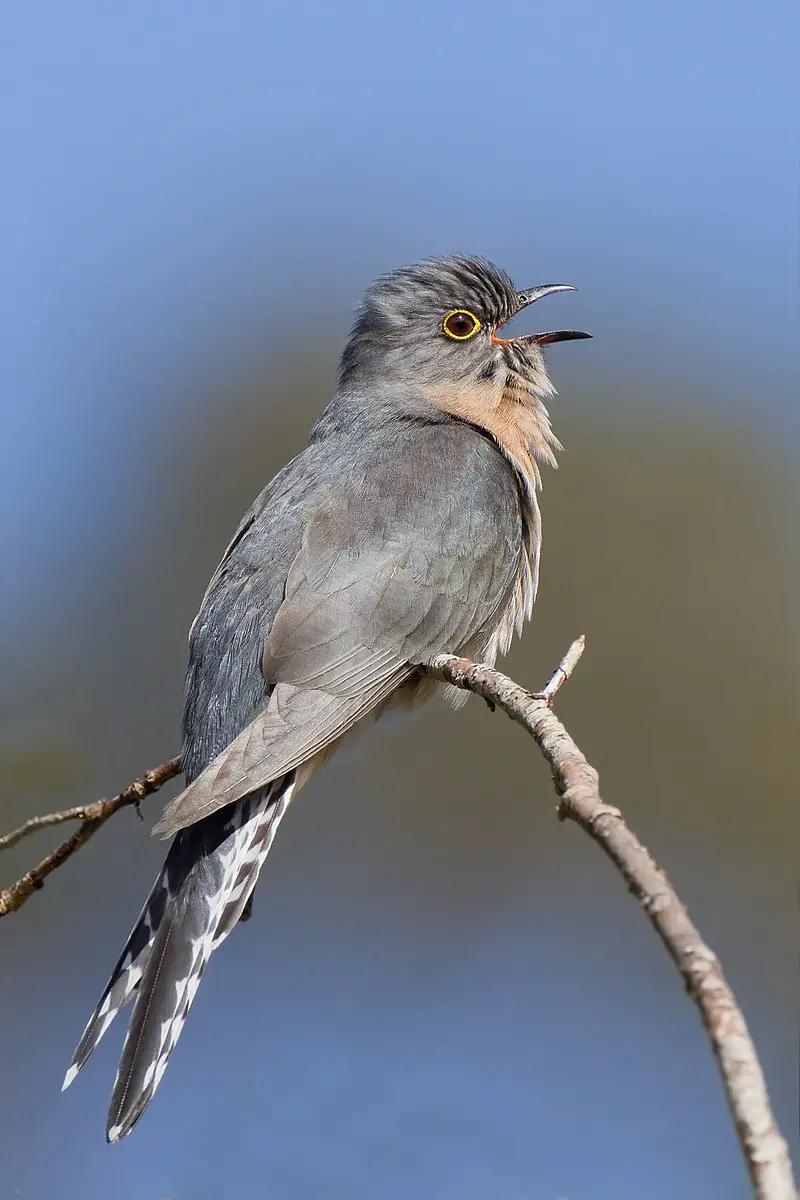
Cuckoos are fascinating birds belonging to the Cuculidae family, which is the only taxon in the order of Cuculiformes.
There are many different species within this family such as common or European cuckoo, roadrunners, koels, malkohas, couas and anis.
Some of these species may even be identified as separate families – Centropodidae and Crotophagidae respectively.
These birds have been known for their unique features such as loud calls heard consistently during certain times of day and night.
They also exhibit behavior like brood parasitism where they lay eggs in other nests so that their chicks can get more food from host parents than its own.
All these traits make them one-of-a-kind creatures worth admiring.Scientific classification:
| Kingdom | Animalia |
| Phylum | Chordata |
| Class | Aves |
| Clade | Otidimorphae |
| Order | Cuculiformes Wagler, 1830 |
| Family | Cuculidae Leach, 1820 |
Also Featured In: Most Common Types of Bangladeshi Birds, Birds of Sweden
20. Woodpeckers
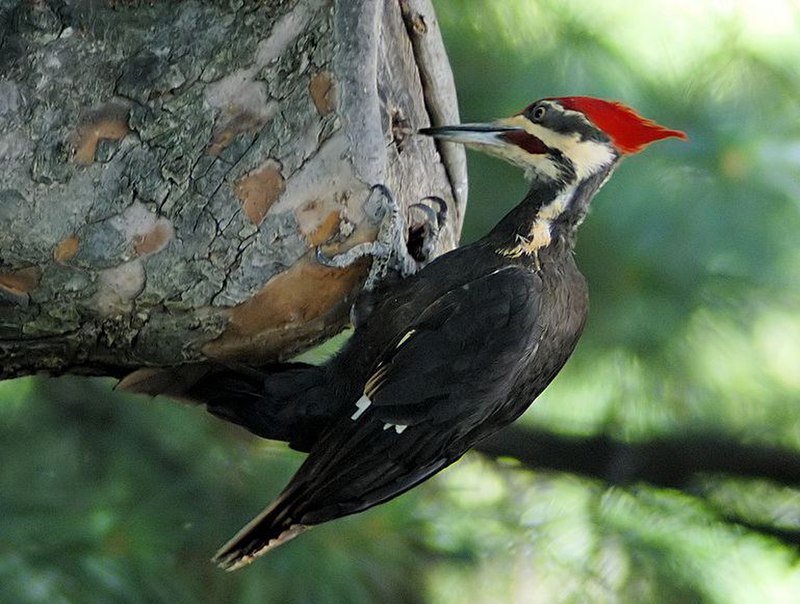
Woodpeckers are an incredibly diverse bird species, found all over the world except for Australia, New Guinea, New Zealand, Madagascar and the extreme polar regions.
They live in a variety of habitats including forests and woodlands but also rocky hillsides and deserts with no trees.
Their beaks are adapted to pecking at tree bark to find food such as insects or larvae hidden beneath it while they use their long tongues to catch them from deep inside crevices.
Woodpeckers have tough skulls that protect their brains from impact when they bang into things during drumming – a behaviour used by males for territorial signalling and reproduction purposes which is done using strong rapid beats against hollow objects like dead branches or metal poles.Scientific classification:
| Kingdom | Animalia |
| Phylum | Chordata |
| Class | Aves |
| Order | Piciformes |
| Infraorder | Picides |
| Family | Picidae Leach, 1820 |
Also Featured In: Common Serbian Birds, Birds of Gran Canaria Island
21. Herons
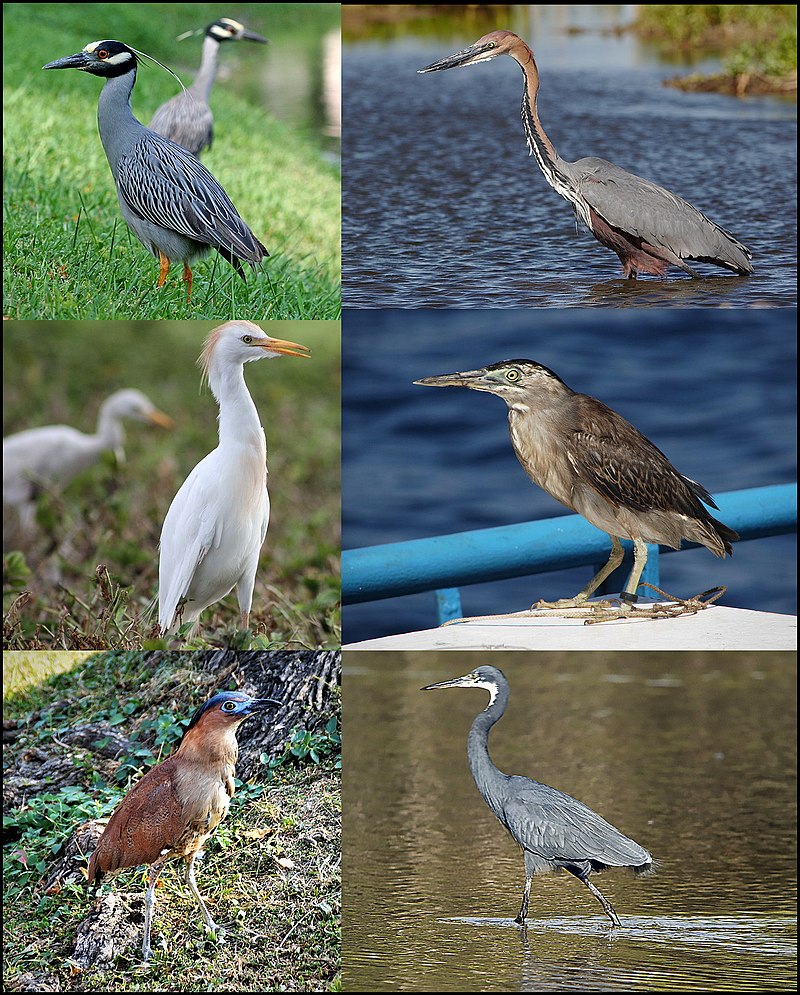
Herons are graceful and elegant birds belonging to the family Ardeidae, with 72 distinct species.
They have long legs and necks that are well-adapted for wading in shallow water like streams or ponds.
Herons can be found near freshwaters as well as along coastal areas worldwide.
Some of these species may also be referred to as egrets, bitterns or zigzag heron/bittern because they belong to certain genera such as Botaurus and Ixobrychus respectively.
These birds stand tall when searching for food by standing still in a shallow body of water while waiting patiently until prey appears before quickly capturing it with their sharp bills.Scientific classification:
| Kingdom | Animalia |
| Phylum | Chordata |
| Class | Aves |
| Order | Pelecaniformes |
| Suborder | Ardei |
| Family | Ardeidae Leach, 1820 |
Also Featured In: Wetlands Birds You Should Know, Birds that Commonly Found in Pond
22. Crow Family
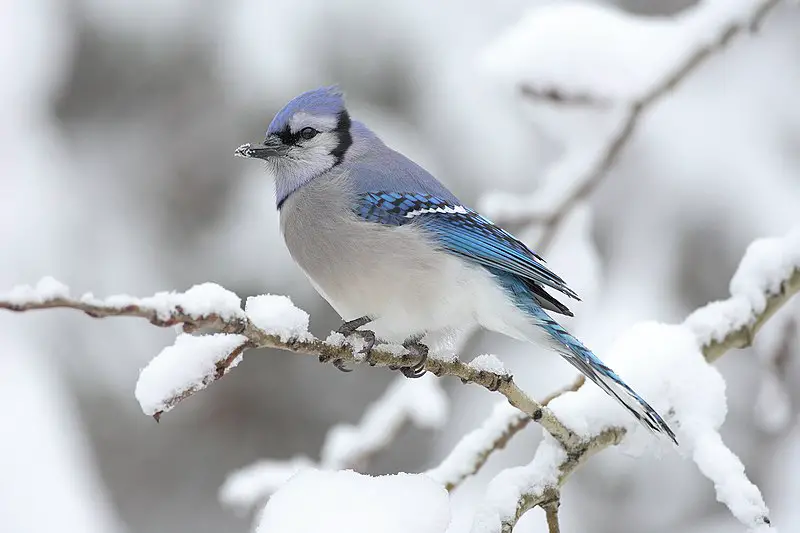
The Crow family is a cosmopolitan group of birds that contains crows, ravens, rooks, jackdaws, jays, magpies and more.
Altogether there are 133 members in this bird family which all share similar characteristics such as large beaks and feet.
The genus Corvus alone makes up over a third of the entire crow family population with species like the common crow or blackbird being some of its most recognizable members.
All these birds have strong social bonds so they often travel in groups to find food sources or build nests together for protection against predators.
With their intelligence and adaptation skills they are able to survive almost anywhere on Earth from mountains to cities making them one of the world’s most successful families of avian creaturesScientific classification:
| Kingdom | Animalia |
| Phylum | Chordata |
| Class | Aves |
| Order | Passeriformes |
| Superfamily | Corvoidea |
| Family | Corvidae Leach, 1820 |
Also Featured In: Common Birds in Japan, Birds of Latvia
23. Passerine
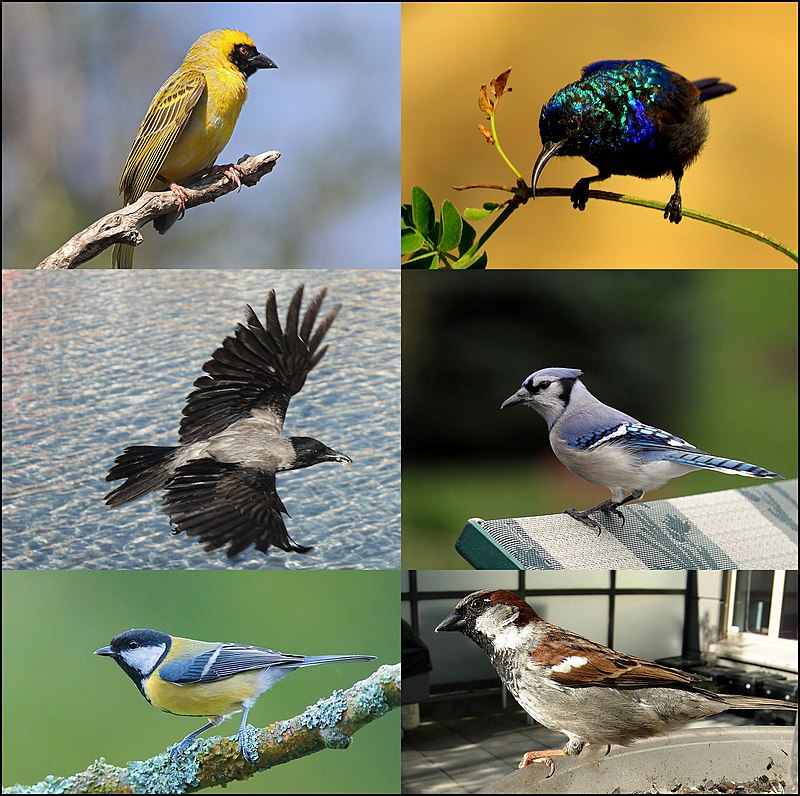
Passerines are a vast order of birds, comprising more than half the species in existence. Many familiar garden and woodland species fall into this category such as sparrows, blackbirds, finches and warblers.
They can be recognised by their arrangement of toes; three pointing forward with one back which helps them perch on branches or wires.
Passerines range from tiny wrens to large crows and have adapted to inhabit many environments around the world including forests, mountainsides and deserts.
They feed mainly on insects but some also consume fruit and seeds depending on their diet preferences.
Their diversity is truly remarkable from vibrant coloured tropical parrots to drab winter thrushes – making passerine birds an integral part of our natural heritage.Scientific classification:
| Kingdom | Animalia |
| Phylum | Chordata |
| Class | Aves |
| Clade | Psittacopasserae |
| Order | Passeriformes Linnaeus, 1758 |
Also Featured In: Egyptian Birds, Native Birds of Kazakhstan
24. Ibis
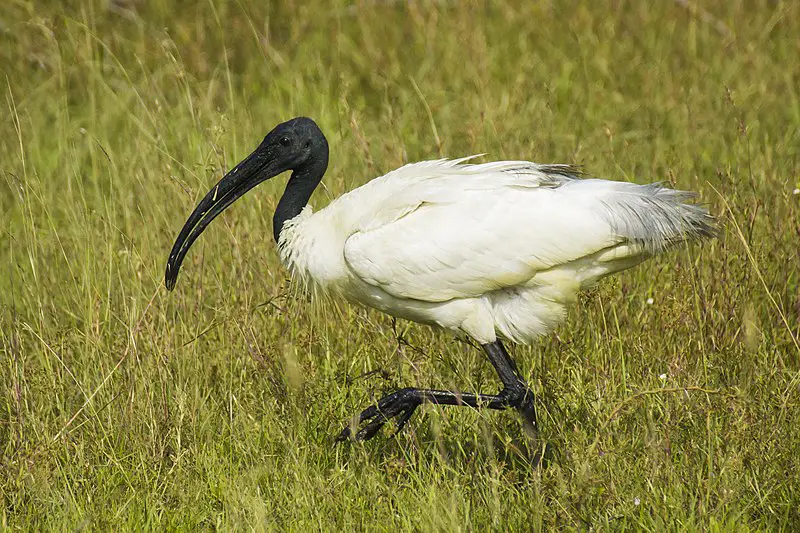
Ibis is a type of long-legged wading bird belonging to the family Threskiornithidae. They inhabit wetlands, forests and plains across many parts of the world.
The name ibis comes from Latin and Ancient Greek words for this group of birds which also can be found in scientific names like Bubulcus ibis – mistakenly identified as bovine animal in 1757.
Ibises have characteristically curved bills used to capture food items such as fishes, reptiles or frogs while they are searching through mud or shallow water with their feet.
Furthermore, these birds usually live in large flocks which helps them protect themselves against predators by keeping an eye out on each other’s safety during hunting times.Scientific classification:
| Kingdom | Animalia |
| Phylum | Chordata |
| Class | Aves |
| Order | Pelecaniformes |
| Family | Threskiornithidae |
| Subfamily | Threskiornithinae Poche, 1904 |
Also Featured In: Swamps Birds You Should Know, Sydney Birds You Need to See
25. Falcon
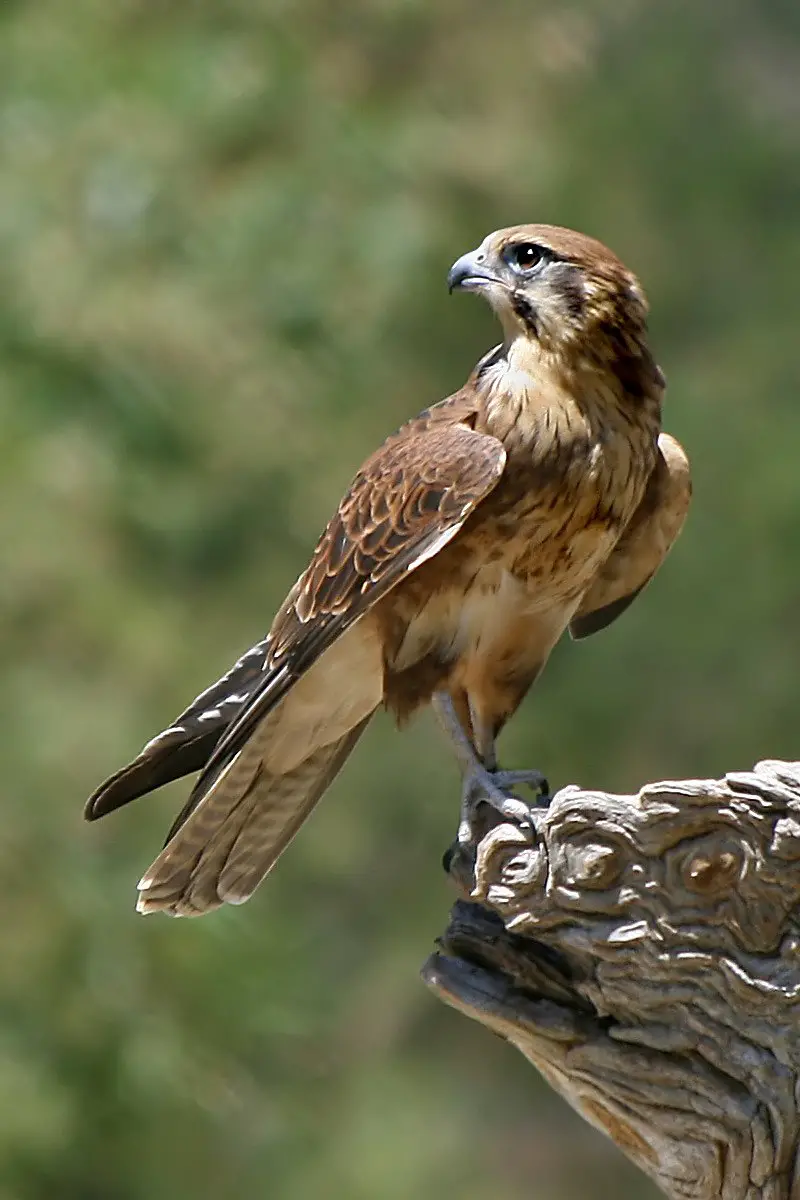
Falcons are majestic birds of prey found in almost all parts of the world, except Antarctica. They have long, slender wings that allow them to fly swiftly and change directions quickly.
As adults they feed on small animals such as mice and insects, but when young their diet consists mainly of carrion or food provided by their parents.
Falcons use a range of techniques for hunting including hovering high up above potential prey before diving down at great speed to catch it during flight.
Additionally they also ambush unsuspecting victims from concealed perches close to the ground.
These remarkable hunters can even take advantage of thermal currents rising off warm surfaces like roads which give them an extra boost while flying.Scientific classification:
| Kingdom | Animalia |
| Phylum | Chordata |
| Class | Aves |
| Order | Falconiformes |
| Family | Falconidae |
| Subfamily | Falconinae |
| Genus | Falco Linnaeus, 1758 |
Also Featured In: Common Carnivore Birds,
26. Common Blackbird
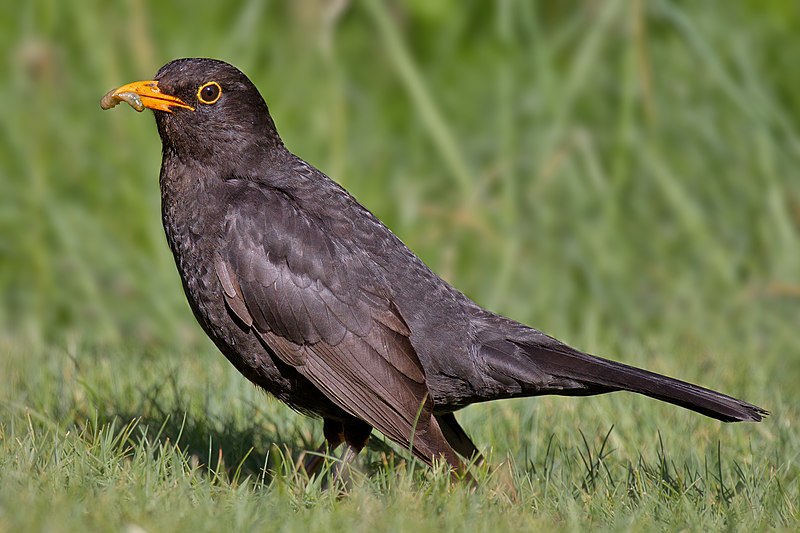
The Common Blackbird is a species of true thrush with the scientific name Turdus merula. Found in Europe, Asiatic Russia and North Africa it has also been introduced to Australia and New Zealand.
The male bird has glossy black plumage while the female’s coloration is more brownish gray.
It is known for its melodious song that can be heard throughout much of the year; typically they are seen alone or in pairs but occasionally form large flocks when food sources become available or during migration periods.
Its diet consists mainly of insects, worms, berries and other fruits as well as some human-provided foods such as bread crumbs or garbage scraps when available.
With its wide distribution range along with ease of adaptation to different habitats this species will likely remain one our most common birds around us.Scientific classification:
| Kingdom | Animalia |
| Phylum | Chordata |
| Class | Aves |
| Order | Passeriformes |
| Family | Turdidae |
| Genus | Turdus |
| Species | T. merula |
Also Featured In: Birds of United Kingdom, Common Birds of Portugal
27. Swallows
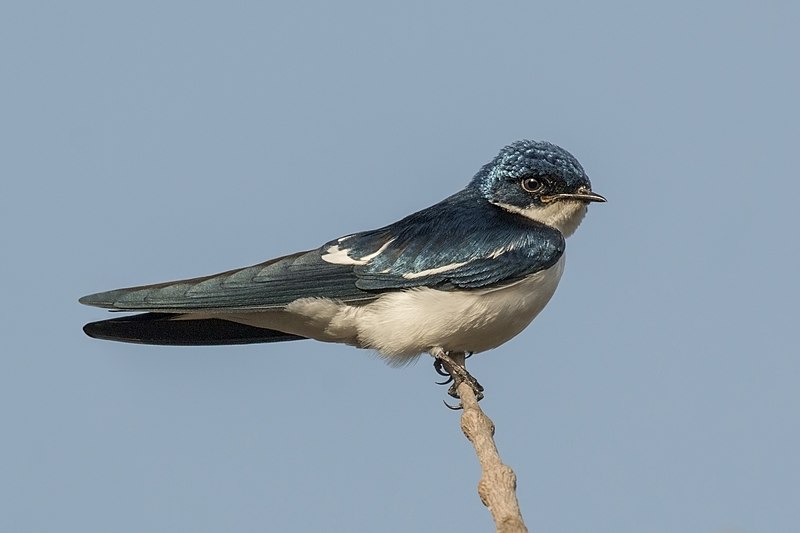
Swallows are small songbirds found around the world on all continents, even Antarctica. They have a distinctive appearance and are highly adapted to aerial feeding with their long wings and forked tail.
There is an estimated 90 species of swallows in 19 different genera, making them one of the most widespread bird families on earth.
The barn swallow is perhaps the most well-known species among these birds due to its presence near human settlements across Europe; they’re so ubiquitous that “swallow” has become synonymous with this particular type of bird there.
Swallows also play important roles in ecology as insectivores; some species migrating vast distances every year between summer breeding grounds and wintering locations.Scientific classification:
| Kingdom | Animalia |
| Phylum | Chordata |
| Class | Aves |
| Order | Passeriformes |
| Suborder | Passeri |
| Family | Hirundinidae Rafinesque, 1815 |
Also Featured In: Most Common Birds of Sierra Islands, Birds You Need To Know Long Key
28. Stork
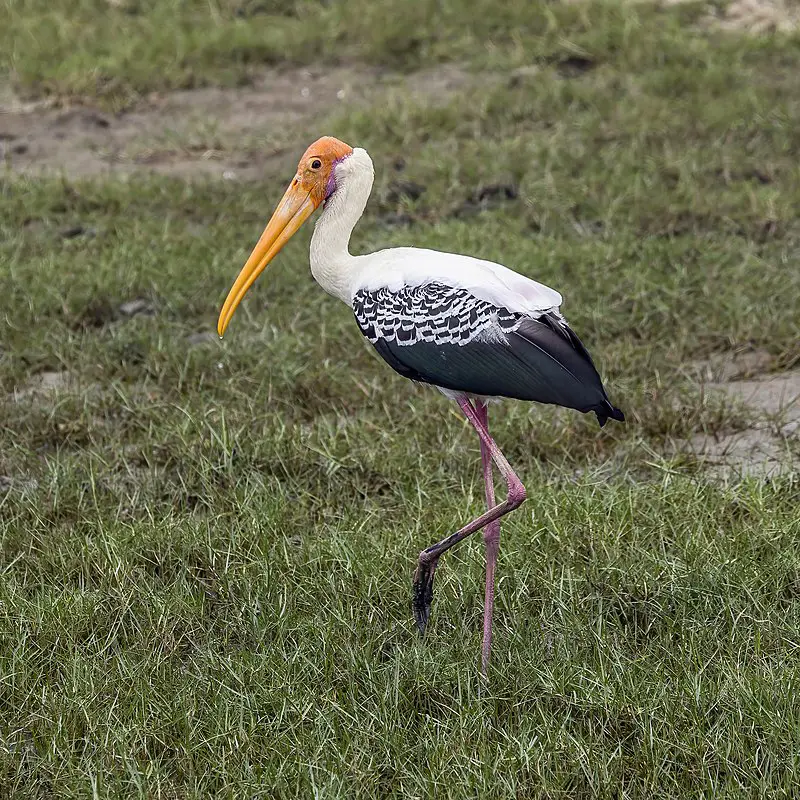
Storks are majestic birds, easily recognizable with their long necks and legs. They belong to the family Ciconiidae, making up the order Ciconiiformes.
Storks inhabit many areas around the world but generally prefer drier habitats than other wading birds like herons or ibises which have been moved to separate orders.
Despite being large in size they can be quite graceful in flight as well as when hunting for food such as insects, small mammals and reptiles near shallow waters.
During nesting season stork pairs build nests on high trees or platforms made of sticks and twigs where they lay eggs that hatch after about a month of incubation time by both parents taking turns sitting on them warmly until hatching day.Scientific classification:
| Kingdom | Animalia |
| Phylum | Chordata |
| Class | Aves |
| Clade | Aequornithes |
| Order | Ciconiiformes Bonaparte, 1854[1] |
| Family | Ciconiidae J. E. Gray, 1840[1] |
Also Featured In: Native South Korean Birds, Bulgarian Birds
29. Larks
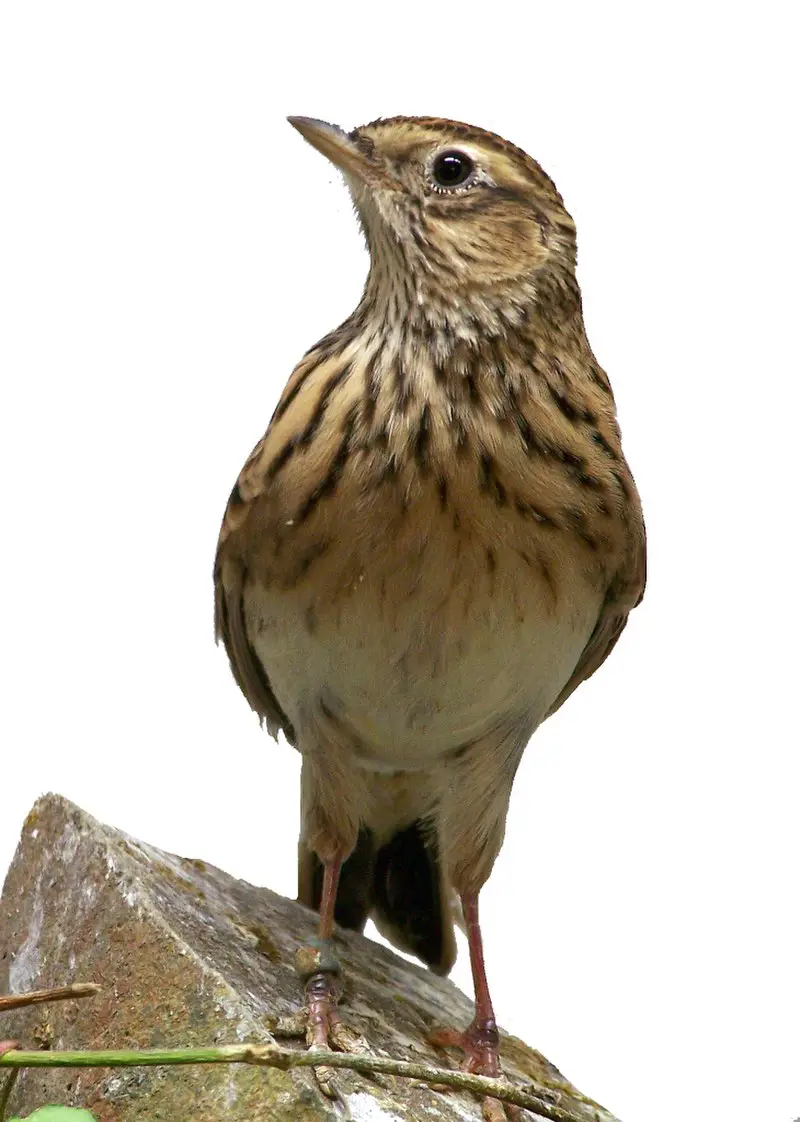
Larks are small passerine birds that belong to the Alaudidae family. These birds have a cosmopolitan distribution and can be found in many different habitats, including dry regions.
The largest number of lark species is located in Africa, while only one species (horned lark) inhabits North America and another one (Horsfield’s bush lark) lives in Australia.
These beautiful creatures usually appear during dawn or dusk as they sing their melodious songs high up into the sky.
Larks possess impressive flying skills which make them capable of reaching heights far above most other bird species.
Despite this skill, they prefer living close to the ground where there are plenty of seeds and insects for them to feed on.Scientific classification:
| Kingdom | Animalia |
| Phylum | Chordata |
| Class | Aves |
| Order | Passeriformes |
| Superfamily | Sylvioidea |
| Family | Alaudidae Vigors, 1825 |
Also Featured In: Birds of Poland, Most Common Spain Birds
30. Common Raven
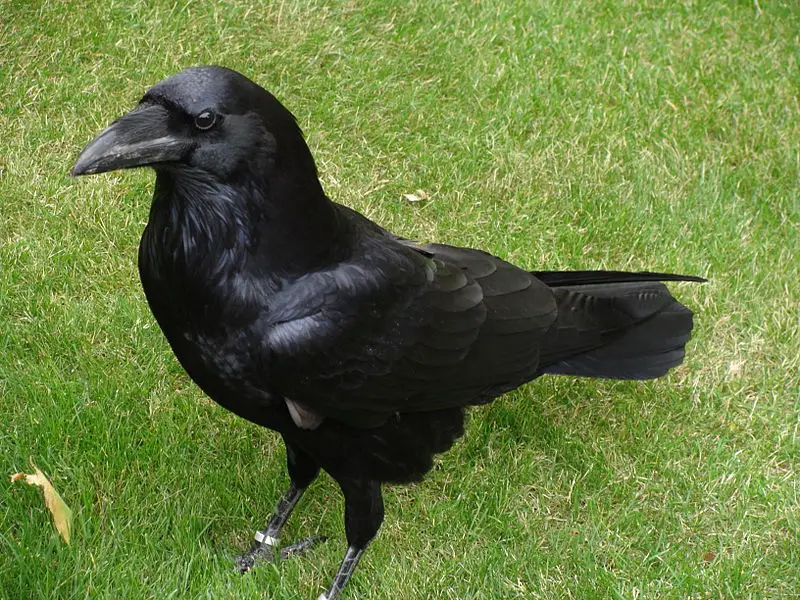
The Common Raven is an iconic black bird found throughout the Northern Hemisphere. It belongs to the Corvus corax species of passerines, and has at least eight subspecies with little physical variation between them.
Recent research however suggests there are significant genetic differences among populations from various areas.
They have a large wingspan of up to 1m and their call can be heard over great distances due to its deep croaking sound; they also use mimicry for communication purposes like many other birds do.
The ravens diet consists mostly of carrion, insects and fruits but they will scavenge in human settlements as well when food sources become scarce.
Their nests require plenty of space so these birds prefer open habitats such as tundra or mountain regions- ideal conditions for their long distance migrations.Scientific classification:
| Kingdom | Animalia |
| Phylum | Chordata |
| Class | Aves |
| Order | Passeriformes |
| Family | Corvidae |
| Genus | Corvus |
| Species | C. corax |
Also Featured In: Birds that Live in San Francisco Bay Area, Scavengers Birds You Should Know
31. Cardinal
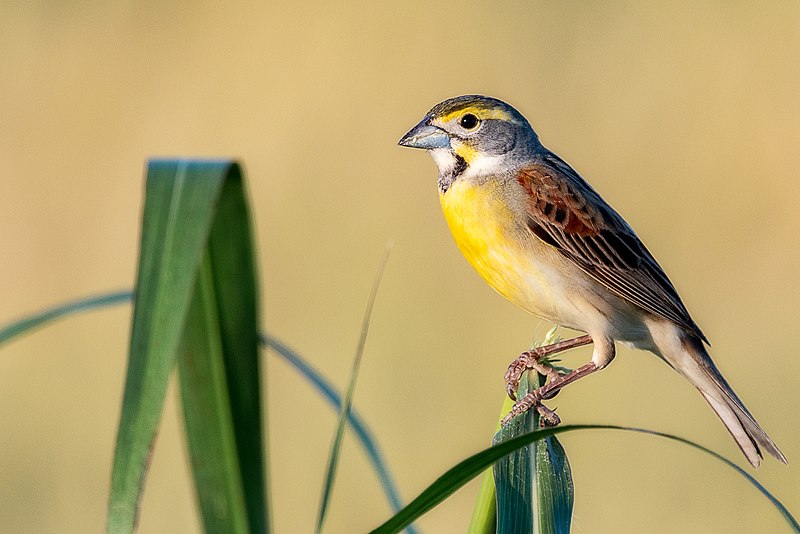
Cardinalidae is a family of passerine birds endemic to the New World that includes cardinals, grosbeaks and buntings.
This large group has great diversity in its members which range from tanager-like Piranga to warbler-like Granatellus.
They are usually distinguished by their bright plumage with reds, oranges and yellows being common among them.
Their strong bills enable them to feed on seeds, fruits and insects as well as other small prey items like lizards or frogs depending upon species.
Cardinals also have loud calls often used for territorial defense and courtship purposes while some can even imitate sounds made by other animals.
These adaptable birds inhabit a variety of habitats across North America making them an important part of many ecosystems there.Scientific classification:
| Kingdom | Animalia |
| Phylum | Chordata |
| Class | Aves |
| Order | Passeriformes |
| Superfamily | Emberizoidea |
| Family | Cardinalidae Ridgway, 1901 |
Also Featured In: Common Birds in Canada, North Carolina Mountain Birds
32. Cyanocitta
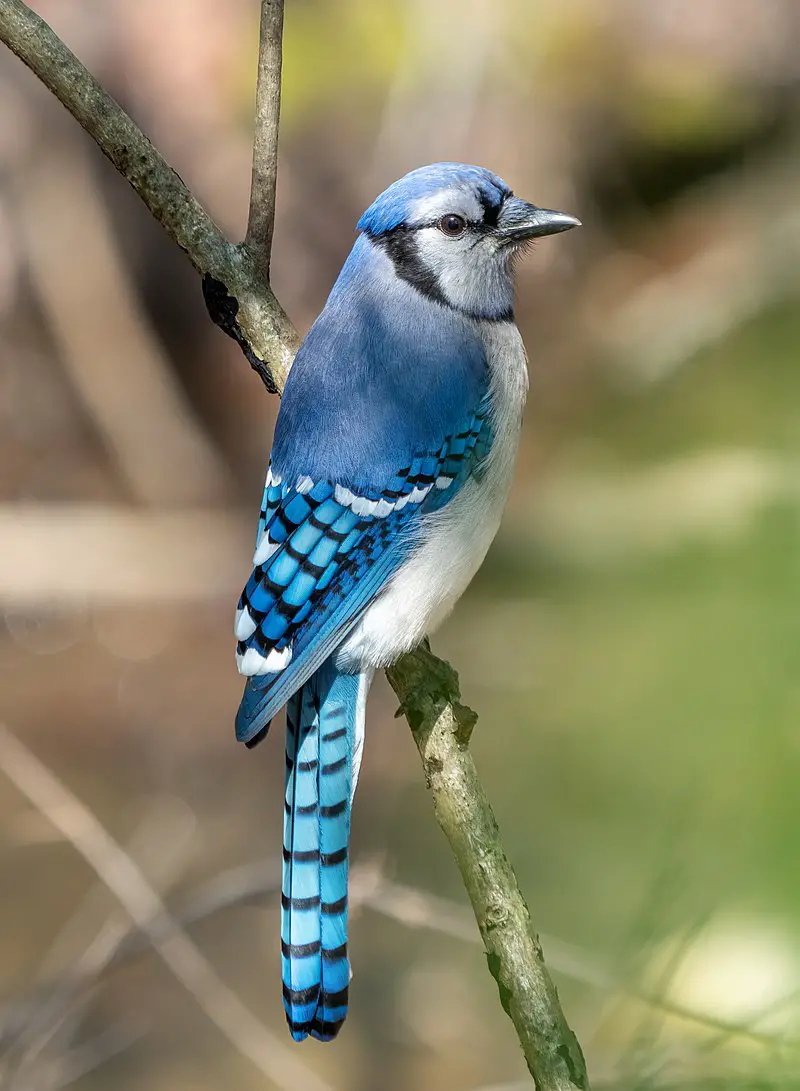
Cyanocitta is a genus of birds belonging to the Corvidae family, which includes crows, jays and magpies. It was established in 1845 by Hugh Edwin Strickland and consists of four species: Steller’s Jay, Blue Jay, Clark’s Nutcracker and Gray Jay.
The name Cyanocitta comes from two Greek words – kuanos meaning “dark blue” and kitta meaning “jay” – which perfectly describes these colourful birds with their bright feathers that range from deep blues to light grays.
They are also known for being very intelligent animals as they can solve complex problems such as opening boxes or finding food hidden under rocks.
As well as this impressive ability, Cyanocittas have been known to mimic human voices.Scientific classification:
| Kingdom | Animalia |
| Phylum | Chordata |
| Class | Aves |
| Order | Passeriformes |
| Family | Corvidae |
| Genus | Cyanocitta Strickland, 1845 |
Also Featured In: Long Island Birds You Should Know, Common Blue Birds of United States of America
33. Parrots
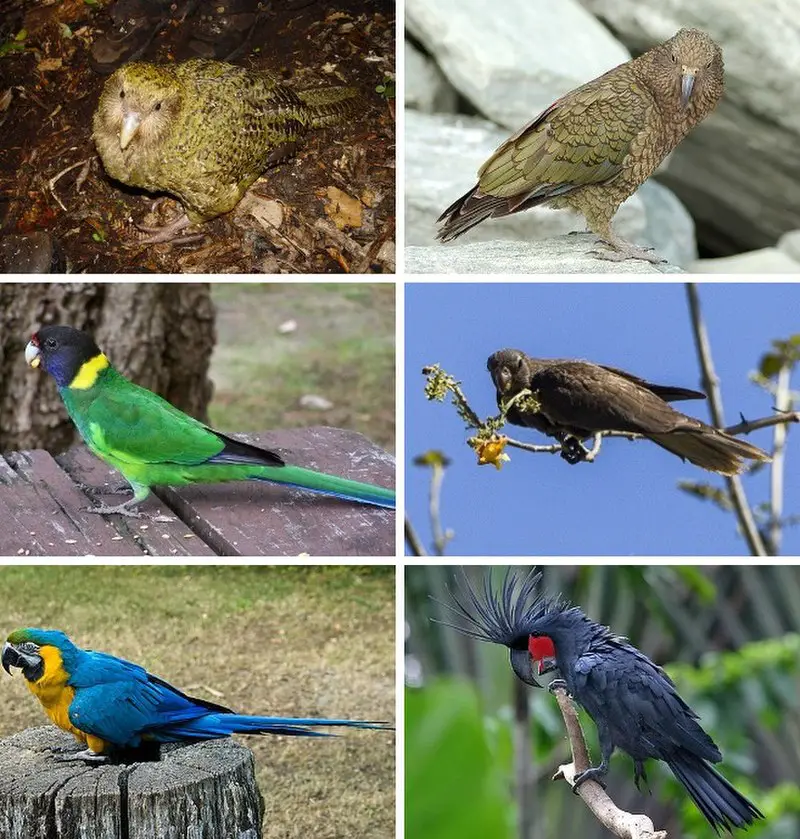
Parrots are a diverse group of birds, found in tropical and subtropical regions. They make up the order Psittaciformes, which is divided into three superfamilies: “true” parrots (Psittacoidea), cockatoos (Cacatuoidea) and New Zealand Parrots (Strigopoidea).
Many species have brightly colored feathers that can be red, yellow or blue. Their strong curved bills allow them to feed on fruits, nuts and seeds.
Parrot behavior ranges from playful to aggressive depending on their environment and socialization with humans.
Some even learn human words. As beloved pets they bring joy to many households around the world though it’s important for owners to understand how best to care for these intelligent creatures so as not to cause distress or harm.Scientific classification:
| Kingdom | Animalia |
| Phylum | Chordata |
| Class | Aves |
| Clade | Psittacopasserae |
| Order | Psittaciformes Wagler, 1830 |
Also Featured In: Most common birds in Australia, Birds That Live in the Jungle
34. Pelican
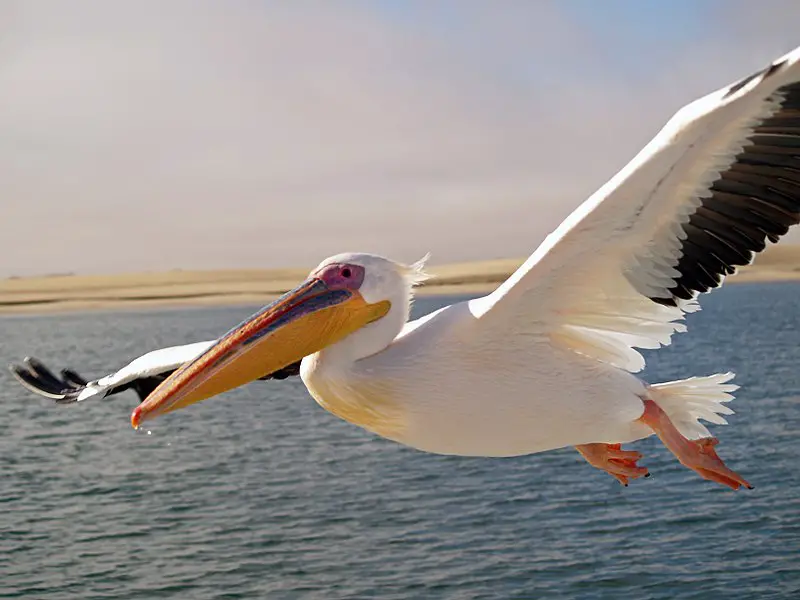
Pelicans are a large water bird and form part of the family Pelecanidae. They have long beaks, allowing them to scoop up prey from both land and sea with ease.
Their most distinctive feature is their huge throat pouch which they use to drain water before swallowing their food.
Most pelican species have predominantly pale plumage however exceptions such as the brown and Peruvian pelicans exhibit darker colouring.
The bill, face skin and pouch of all Pelican species become brightly coloured during breeding season in order to attract mates.
Pelicans can often live up to 25 years due to the fact that they eat mostly fish which provides them with enough nutrients for longevity.Scientific classification:
| Kingdom | Animalia |
| Phylum | Chordata |
| Class | Aves |
| Order | Pelecaniformes |
| Family | Pelecanidae |
| Genus | Pelecanus Linnaeus, 1758 |
Also Featured In: Birds You’ll Find in the Sea, Birds that Live in the Ocean
35. Crows
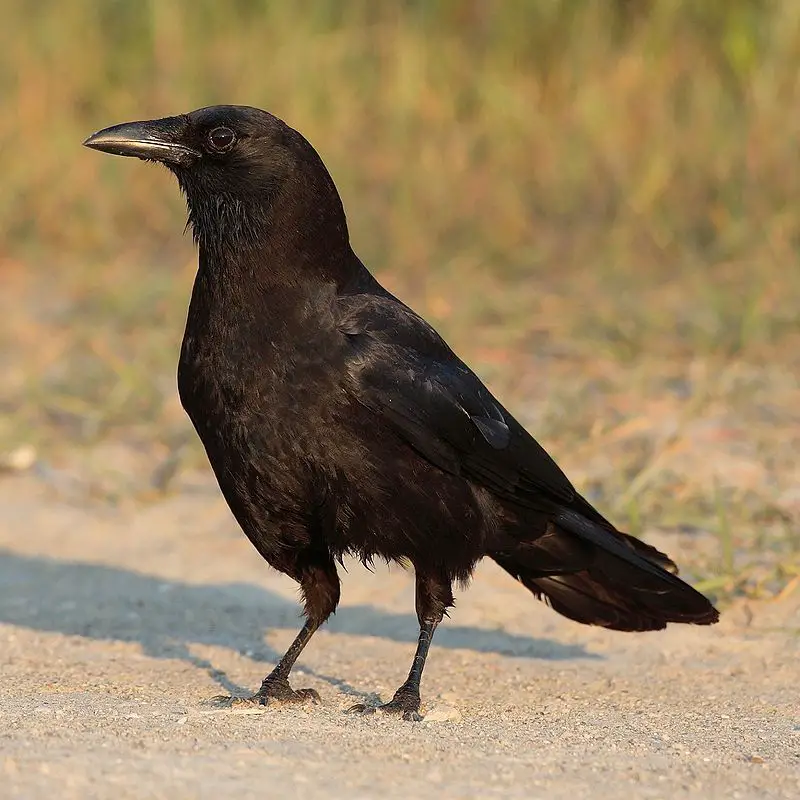
Crows are medium to large birds with a wide range of species belonging to the Corvidae family. They can be found in Europe, Asia, America and Australia.
Common crows include carrion crow, hooded crow, common raven and rooks which differ mainly by size; crows being generally smaller than their counterparts.
Crows have distinctive black feathers that contrast against their white eyes while they possess an intelligence far beyond other birds as they will use tools for tasks like cracking open nuts or making nests out of twigs.
Their curious nature makes them great problem-solvers when faced with challenging situations such as finding food sources or navigating new terrain.Scientific classification:
| Kingdom | Animalia |
| Phylum | Chordata |
| Class | Aves |
| Order | Passeriformes |
| Family | Corvidae |
| Subfamily | Corvinae |
| Genus | Corvus Linnaeus, 1758 |
Also Featured In: Birds of Netherlands,
36. Red-Tailed Hawk
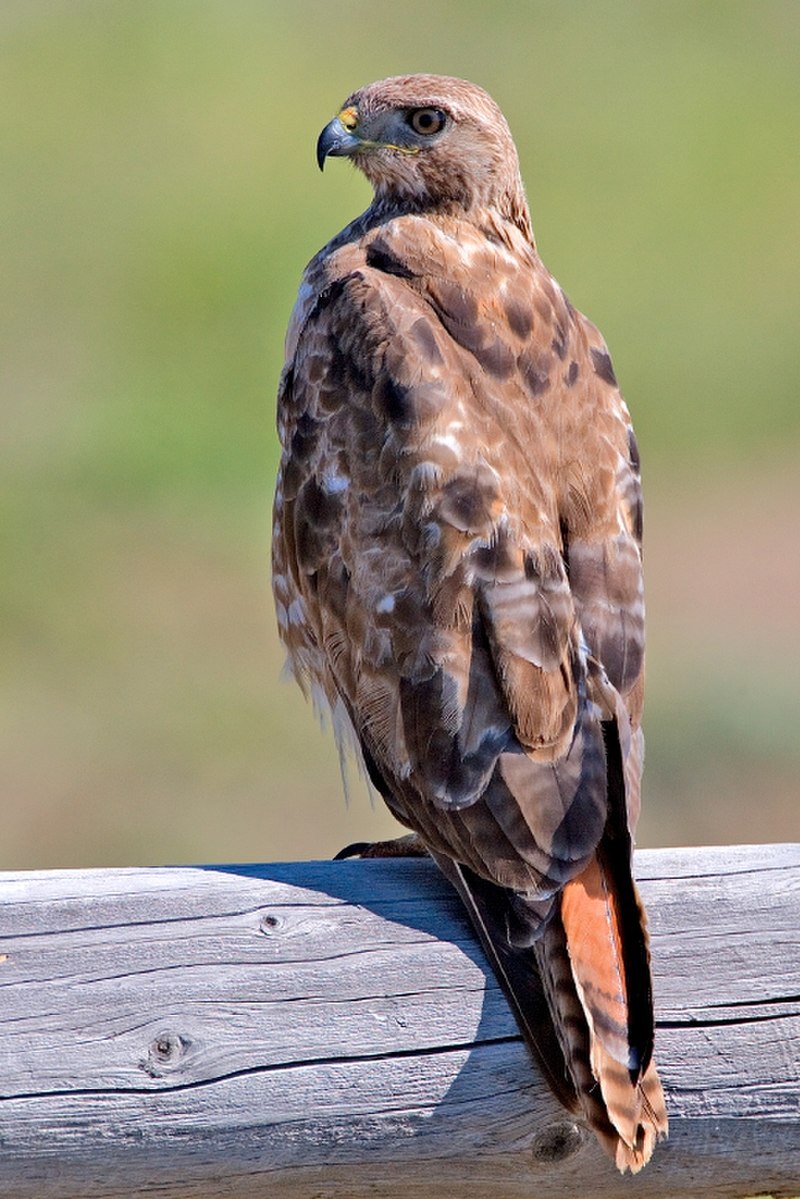
The Red-tailed Hawk is a majestic bird of prey with its distinctive red tail. It can be found throughout North America, from Alaska in the north to Panama and the West Indies in the south.
This species belongs to Buteo genus, which makes it one of most common raptors on earth.
These hawks mainly hunt small mammals such as rabbits or squirrels but also feed on reptiles and birds during migration season.
Unlike other predator birds, they prefer open areas for hunting like fields or grasslands rather than dense forests.
They build their nests high up on trees where they stay all year long unless disturbed by humans or animals nearby.
Their presence has become an iconic part of American culture due to their frequent sightings around homes and parks alike making them beloved creatures among people everywhere.Scientific classification:
| Kingdom | Animalia |
| Phylum | Chordata |
| Class | Aves |
| Order | Accipitriformes |
| Family | Accipitridae |
| Genus | Buteo |
| Species | B. jamaicensis |
Also Featured In: Dominican Republic birds, Birds that Live in Mississippi
37. Albatrosses
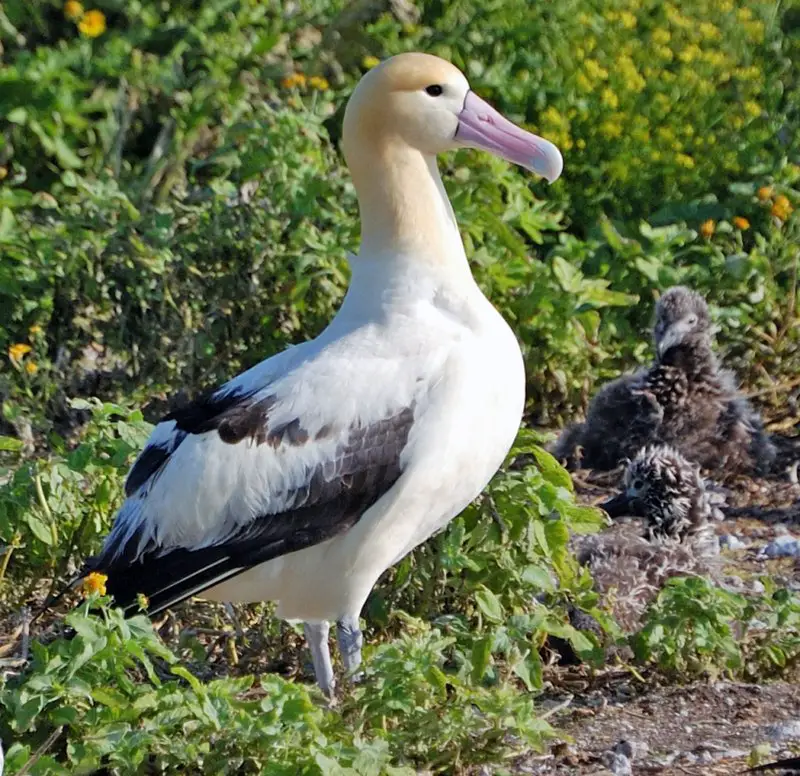
Albatrosses are majestic, large seabirds belonging to the Diomedeidae family in the Procellariiformes order.
These birds have an impressive wingspan and can fly great distances over oceans with minimal effort.
They inhabit all of the world’s southern oceans, ranging from Antarctica up through New Zealand and Australia as well as parts of the northern Pacific Ocean region.
Albatross populations were once abundant throughout much of their range but they now face threats such as longline fishing gear entanglement which has caused a significant decline in numbers in some areas.
Furthermore, occasional vagrants have been found outside their native ranges including fossil remains suggesting that albatrosses previously existed on other regions too.Scientific classification:
| Kingdom | Animalia |
| Phylum | Chordata |
| Class | Aves |
| Order | Procellariiformes |
| Family | Diomedeidae G.R. Gray 1840[1] |
Also Featured In: New Zealand Birds, Galapagos Birds You Should Know
38. Penguins
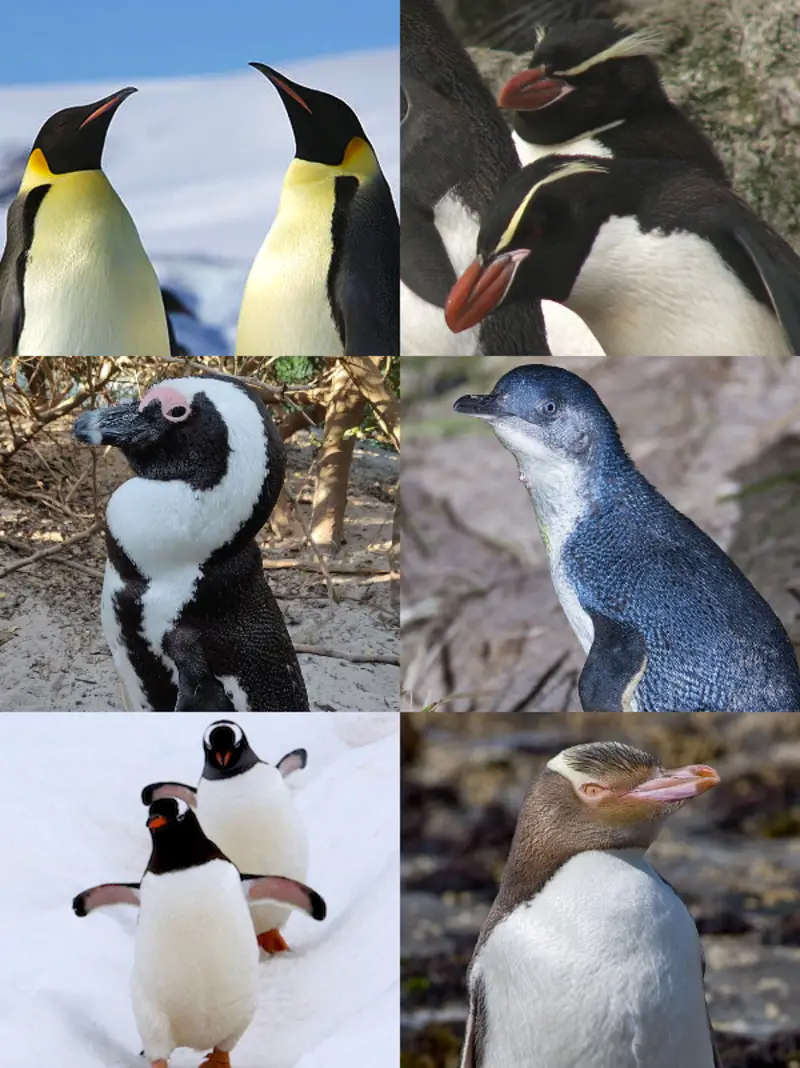
Penguins are an amazing species of aquatic birds that live mainly in the Southern Hemisphere. They have a unique plumage, which is black and white countershaded to aid them while swimming in the water.
Penguins feed mostly on krill, small crustaceans found near Antarctica. These remarkable creatures can’t fly but they compensate by being excellent swimmers due to their flippers-like wings which help them move faster underwater.
All this makes penguins one of nature’s most fascinating animals – not just for kids.Scientific classification:
| Kingdom | Animalia |
| Phylum | Chordata |
| Class | Aves |
| Clade | Austrodyptornithes |
| Order | Sphenisciformes Sharpe, 1891 |
| Family | Spheniscidae Bonaparte, 1831 |
Also Featured In: Antarctica Birds, Large African Birds You Need to Know
39. Grouse
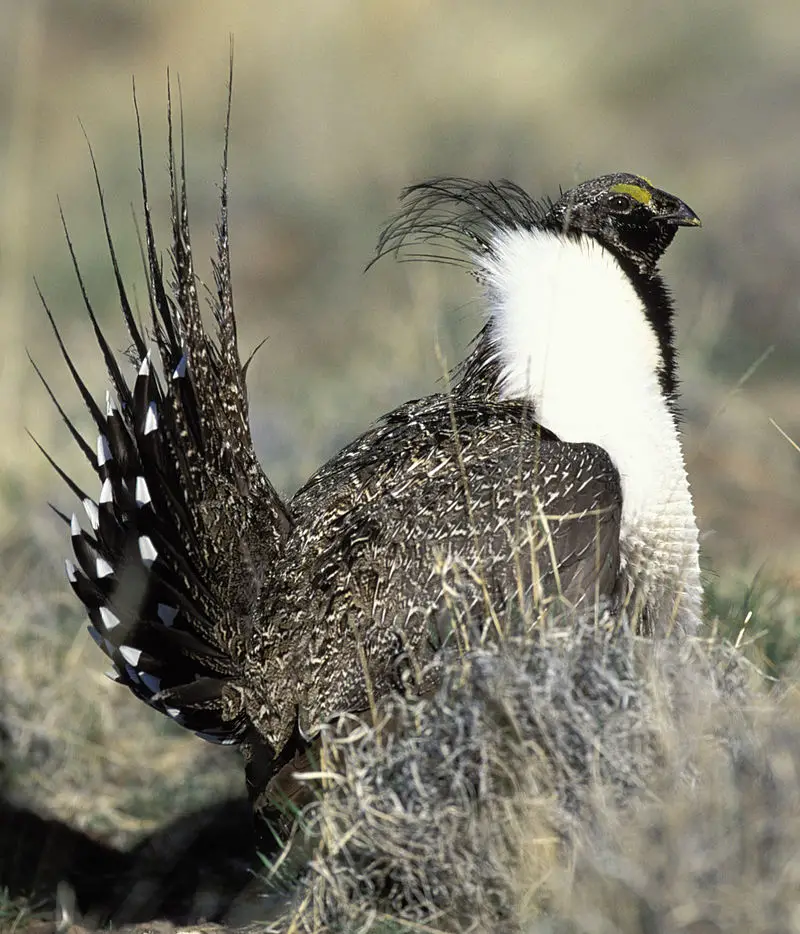
Grouse are a type of game bird found in the family Phasianidae. They belong to the order Galliformes and tribe Tetraonini for classification purposes, as supported by modern mitochondrial DNA sequence studies.
Grouse can be identified from their characteristic plump body shape, short wings and tail feathers, strong legs with sharp claws that enable them to move swiftly through dense underbrush.
These birds also have feathered crowns atop their heads which may contain small patches or crests depending on species.
The males tend to be larger than females and usually feature brighter plumage during mating season when they attract mates with an elaborate display of wing-flapping and vocalization while trying to ward off potential rivals simultaneously.Scientific classification:
| Kingdom | Animalia |
| Phylum | Chordata |
| Class | Aves |
| Order | Galliformes |
| Family | Phasianidae |
| Subfamily | Phasianinae |
| Tribe | Tetraonini Leach, 1820 |
Also Featured In: Alaska Birds,
40. Old World Sparrows
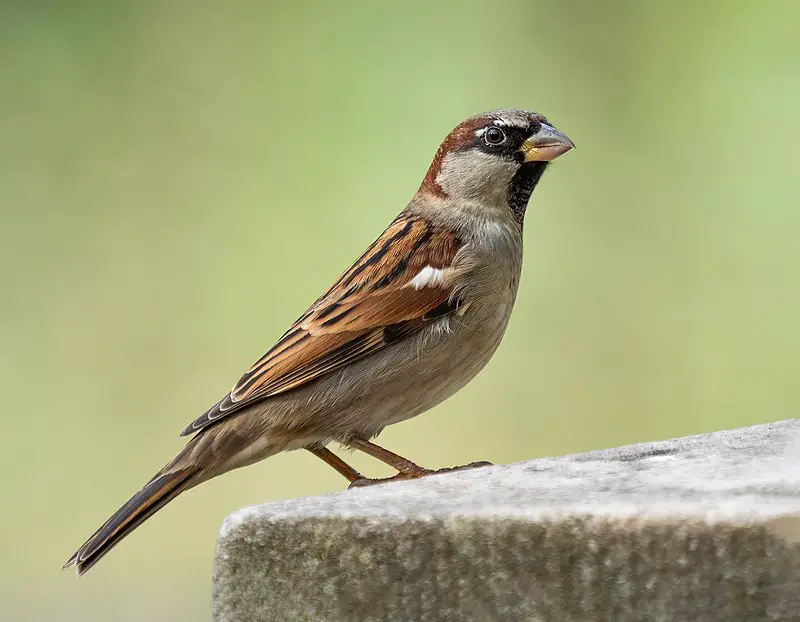
Old World sparrows are small passerine birds belonging to the family Passeridae. They are characteristically much smaller than their New World counterparts, ranging in size from 6 centimeters up to 20 centimeters depending on species.
The most common characteristics of these birds include a black or grey head and upper body with white underparts and white stripes above their eyes.
Notable features such as barring and streaking can be found across different species within this group.
Old world sparrows typically inhabit open grassland areas but have been known to nest around human dwellings near urban settings as well, making them easily recognizable by many people all over the globe.Scientific classification:
| Kingdom | Animalia |
| Phylum | Chordata |
| Class | Aves |
| Order | Passeriformes |
| Suborder | Passeri |
| Infraorder | Passerida |
| Superfamily | Passeroidea |
| Family | Passeridae Rafinesque, 1815 |
Also Featured In: Most Common Winter Birds, Famous Paintings Birds
41. Roadrunner
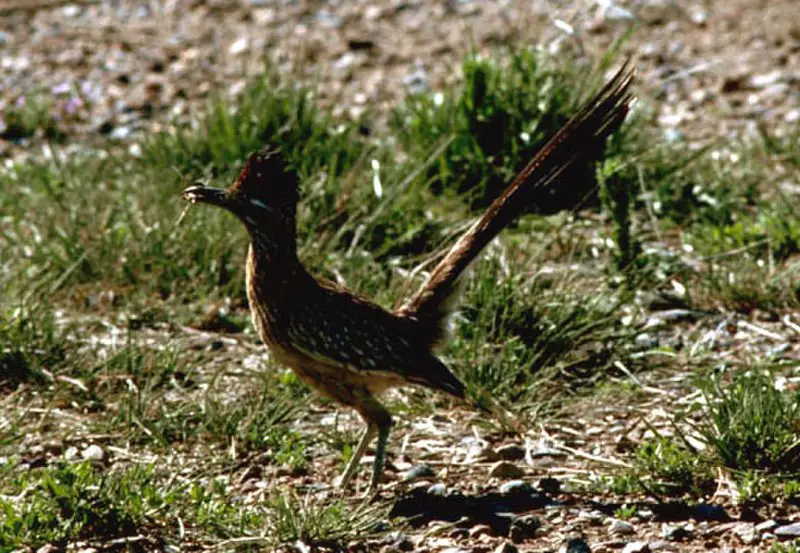
Roadrunners are fast-running ground cuckoos with long tails and crests, found mainly in the deserts of the southwestern United States and Mexico.
They can fly but usually prefer to run away from predators at speeds reaching up to 32km/h.
Their diet consists mostly of insects, lizards and small rodents.
Roadrunners have unique mating rituals where male birds will perform a dance for their mate before they build nests together out of sticks or other materials on low bushes or even directly on the ground.
These birds also make very distinct calls that sound like “beep beep” which is how they got their name – roadrunner.Scientific classification:
| Kingdom | Animalia |
| Phylum | Chordata |
| Class | Aves |
| Order | Cuculiformes |
| Family | Cuculidae |
| Subfamily | Neomorphinae |
| Genus | Geococcyx Wagler, 1831 |
Also Featured In: birds of New Mexico, Birds that Live in the Deserts
42. Swans
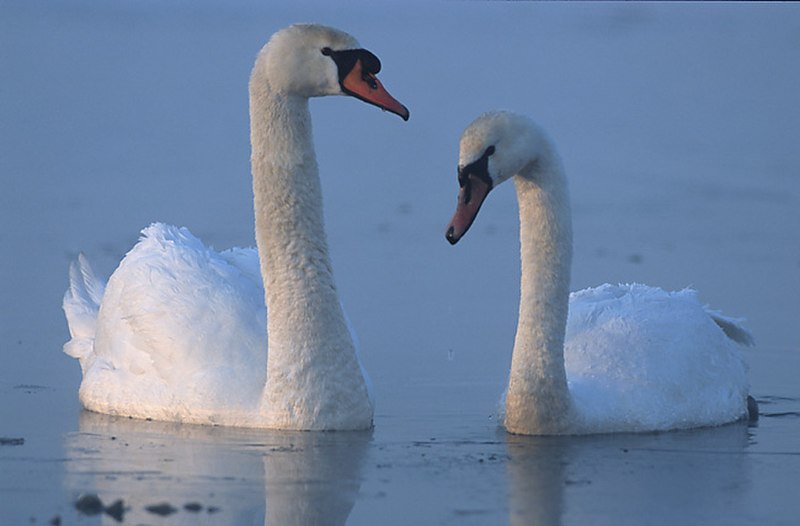
Swans are graceful and elegant birds belonging to the family Anatidae. They have a long neck, black beak and large wings that give them their majestic look.
Their closest relatives include geese and ducks who belong to the same subfamily Anserinae as swans do.
There are six living species of swan found in different parts of the world – Mute Swan, Black-necked Swan, Tundra Swan, Whooper Swan, Trumpeter Swan and Coscoroba Swam.
These beautiful creatures usually live on lakes or rivers but can also inhabit wetlands such as marshes or estuaries for nesting purposes.
Despite being very social animals with strong pair bonds they remain solitary during migration periods when they travel long distances looking for better feeding grounds.Scientific classification:
| Kingdom | Animalia |
| Phylum | Chordata |
| Class | Aves |
| Order | Anseriformes |
| Family | Anatidae |
| Subfamily | Anserinae |
| Genus | Cygnus Garsault, 1764 |
Also Featured In: birds of white, Water Birds Live around Us
43. Columbidae
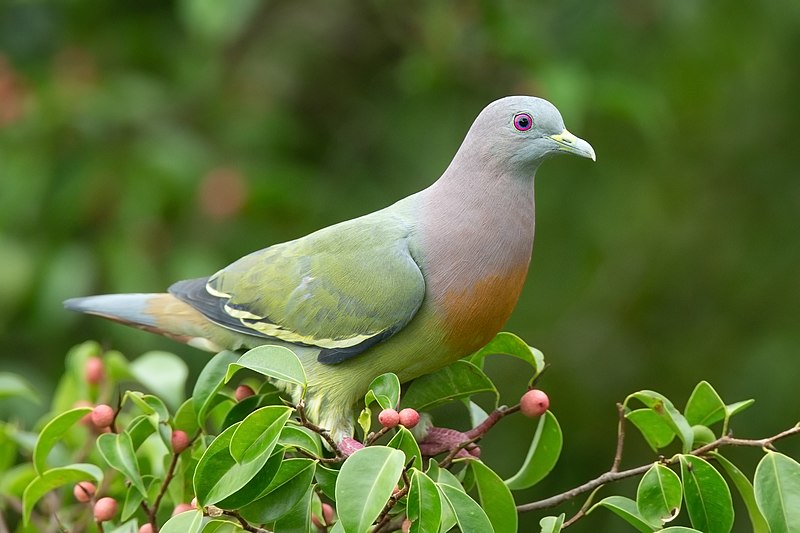
Columbidae is a bird family that includes both doves and pigeons. These birds are characterized by their stout bodies, short necks, and small slender bills with fleshy ceres in some species.
They feed mainly on seeds, fruits, and plants found all around the world but have the greatest variety in Indomalayan and Australasian regions.
Columbidae have an unmistakable soft cooing sound which makes them one of the most beloved avian families worldwide – especially among city dwellers.
Whether it be feeding time or just hearing their soothing call throughout nature walks; these birds will remain a favourite for many more years to come.Scientific classification:
| Kingdom | Animalia |
| Phylum | Chordata |
| Class | Aves |
| Clade | Columbimorphae |
| Order | Columbiformes Latham, 1790 |
| Family | Columbidae Leach, 1820 |
Also Featured In: Birds for Your Home Garden, Flight Birds You Should Know
44. Common Quail

The Common quail (Coturnix coturnix) is a small ground-nesting game bird of the Phasianidae family. It breeds in western Palearctic and winters in Africa, India and southern parts of Europe.
Its distinctive call consists of three repeated chirps making it easier to identify than see.
They are widespread across their range, preferring grassy habitats with plenty of cover such as meadows, fields or pastures near water sources like streams or marshes for easy access to food and protection from predators.
With its strong flying ability they migrate long distances over vast areas during different seasons looking for suitable habitats throughout the year.Scientific classification:
| Kingdom | Animalia |
| Phylum | Chordata |
| Class | Aves |
| Order | Galliformes |
| Family | Phasianidae |
| Genus | Coturnix |
| Species | C. coturnix |
Also Featured In: Highland Birds That You Should Know, Italian Birds You Should Know
45. Common Nightingale
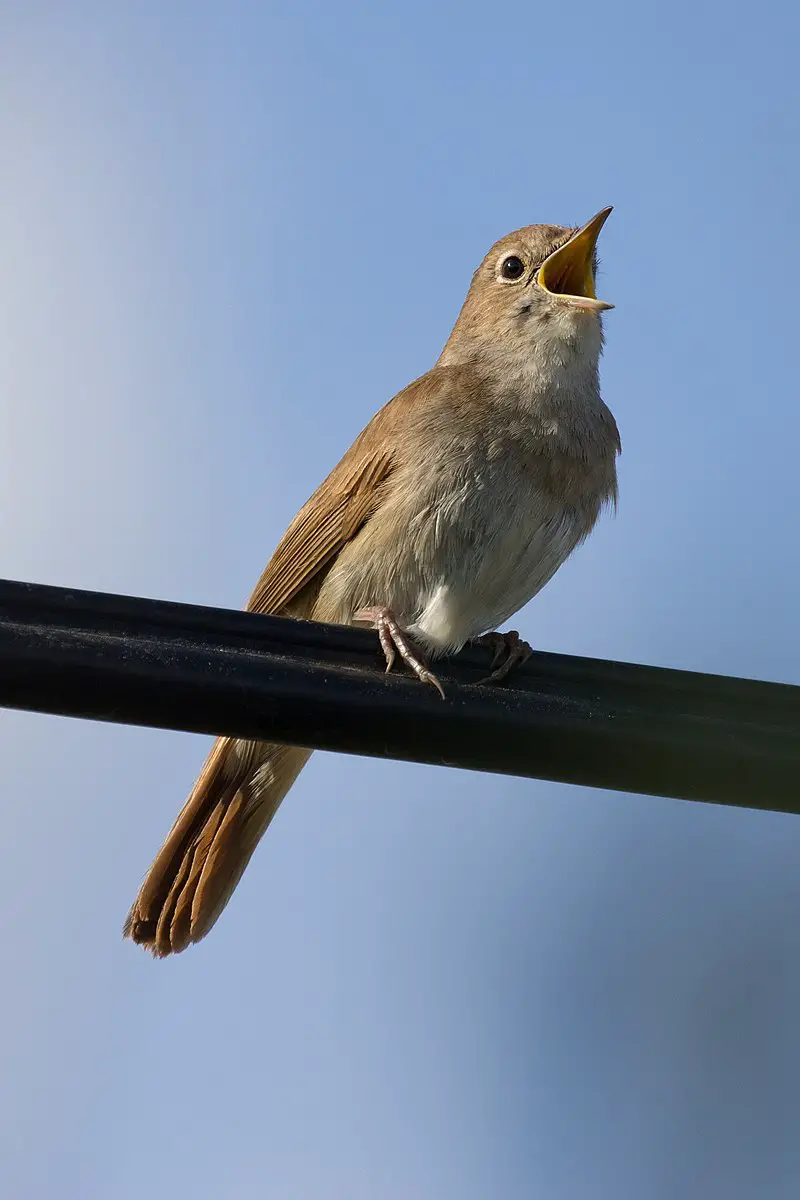
The Common nightingale, also called the rufous nightingale, is a small bird known for its beautiful and powerful song. It was formerly considered a thrush, but is now classified as an Old World flycatcher.
The bird is a member of the Muscicapidae family, and is often referred to as a chat due to its terrestrial behavior.
The nightingale’s song is widely appreciated for its melodious and varied notes. The plumage of the bird is brown, with a hint of reddish color, and it has a stout beak for feeding on insects.
The Common nightingale can be found throughout Europe, Western Asia, and parts of Africa.
Overall, the bird is known for its vibrant and distinctive singing voice.Scientific classification:
| Kingdom | Animalia |
| Phylum | Chordata |
| Class | Aves |
| Order | Passeriformes |
| Family | Muscicapidae |
| Genus | Luscinia |
| Species | L. megarhynchos |
Also Featured In: Most Common Songs Birds that Live around You, Birds You’ll Find in Night
46. European Robin
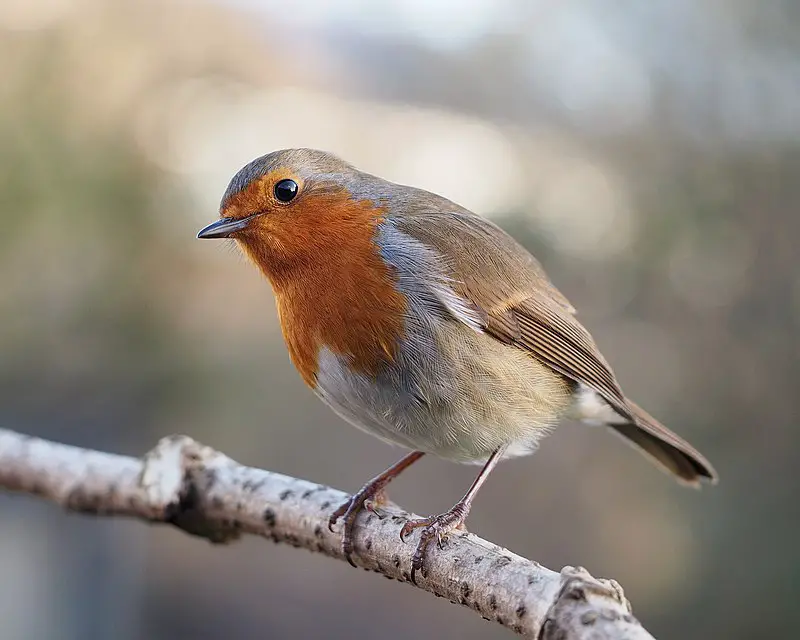
The European robin, also known as simply robin or robin redbreast, is a small insect-eating bird belonging to the chat subfamily.
This bird species can be found across Europe, extending east to Western Siberia while inhabiting North Africa.
The bird species is relatively sedentary and is found in most of its range, except for the far north.
Measuring around 12.5-14.0 cm, this bird is commonly known for its distinctively red breast feathers.
As an insectivorous passerine bird, the European robin mainly feeds on insects to sustain its energy.
Given its widespread range throughout Europe and continuous presence in certain parts of the world, the European robin is widely recognized for its distinct physical appearance, singsong voice, and tiny size.Scientific classification:
| Kingdom | Animalia |
| Phylum | Chordata |
| Class | Aves |
| Order | Passeriformes |
| Family | Muscicapidae |
| Genus | Erithacus |
| Species | E. rubecula |
Also Featured In: Ukrainian Birds You Should Know, Most Common Romanian Birds
47. Owls
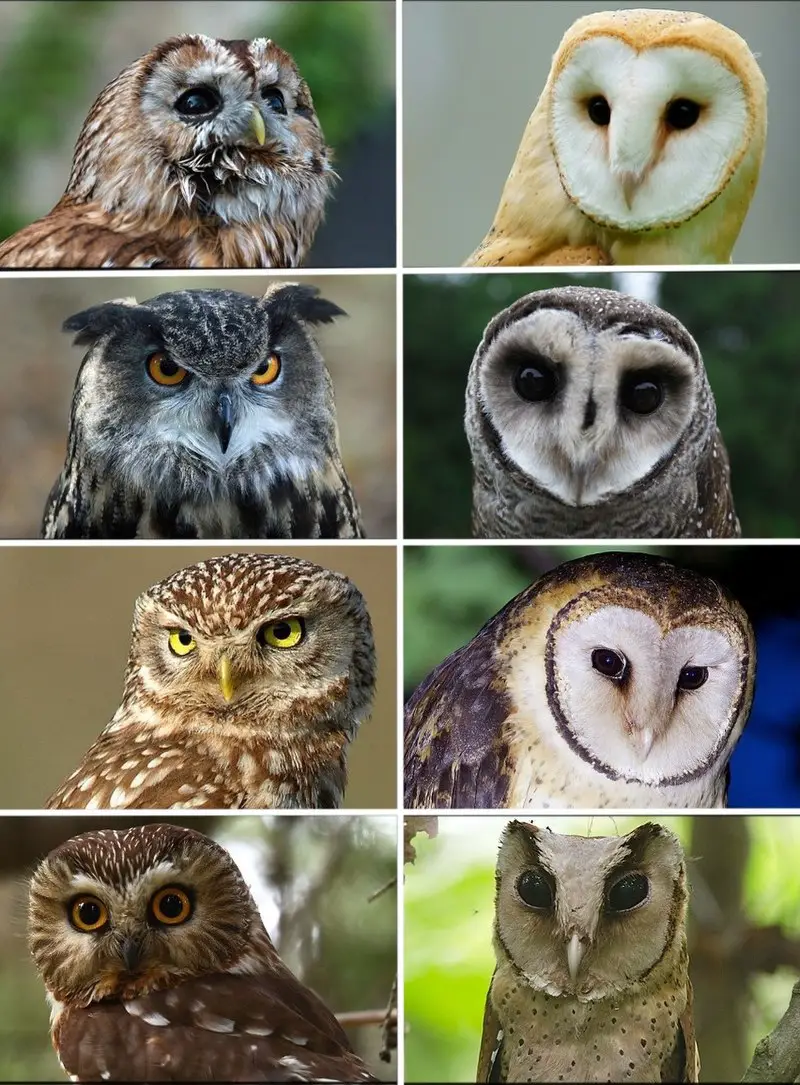
Owls are remarkable birds of prey that belong to the order Strigiformes. Known for their solitary and nocturnal behavior, these birds are commonly associated with an upright stance, broad head, binocular vision, binaural hearing, sharp talons, and specially adapted feathers for silent flight.
With over 200 species, owls are mostly carnivorous and hunt small mammals, making them excellent at controlling rodent populations.
Although most owls are solitary animals, some species, such as the gregarious burrowing owl, are social and interact regularly with their own kind.
Despite their nocturnal habits, some owls, like the northern hawk-owl, are diurnal and hunt during daylight hours.
All in all, owls are fascinating creatures that have intrigued bird watchers and scientists alike for many years.Scientific classification:
| Kingdom | Animalia |
| Phylum | Chordata |
| Class | Aves |
| Clade | Telluraves |
| Order | Strigiformes Wagler, 1830 |
Also Featured In: Birds You’ll Find in Zoo, Most Common Nature Birds
48. Common Ostrich
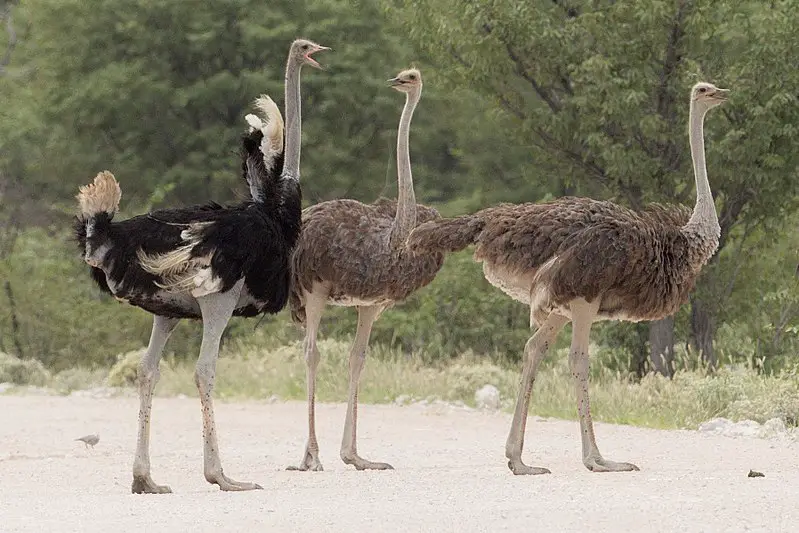
The common ostrich, also known as Struthio camelus, is a flightless bird and the largest living species of bird in the world.
They are native to specific regions of Africa and are the only living members of their genus, Struthio, in the ratite order of birds.
Another ostrich species, the Somali ostrich, is the only other member of the genus Struthio. Common ostriches are known for their long necks and legs, with their wings being too small for flight.
They have an omnivorous diet, feeding on plants, insects, and small animals.
During mating season, males engage in courtship displays and compete for mates, with the females laying their eggs in a communal nest.
These birds are important ecologically and culturally, but they are also threatened by habitat loss and hunting for their meat, feathers, and skin.Scientific classification:
| Kingdom | Animalia |
| Phylum | Chordata |
| Class | Aves |
| Infraclass | Palaeognathae |
| Order | Struthioniformes |
| Family | Struthionidae |
| Genus | Struthio |
| Species | S. camelus |
Also Featured In: African Birds, Savanna Birds You Need to See
49. Ostriches
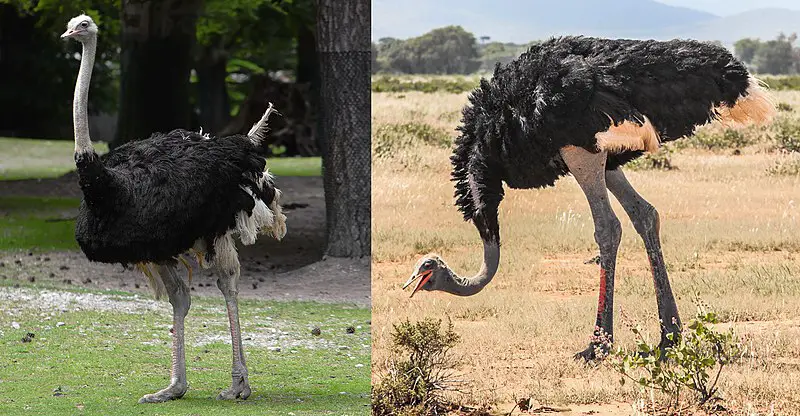
Ostriches are massive birds that cannot fly. They lay the biggest eggs amongst land animals. These birds are remarkable sprinters, with a top speed of 70 km/h.
They are farmed in several countries, with the Philippines and Namibia being the most significant producers.
Famed for their leather, ostriches are bred for their hides, which are in high demand for their durability and aesthetics.
Their long and thick plumes are often used as decorations or in fashion accessories.
Despite their size, ostriches are primarily herbivores, feeding on shoots, leaves, flowers, and grass. They are social animals and live in groups of up to 50 in the wild.Scientific classification:
| Kingdom | Animalia |
| Phylum | Chordata |
| Class | Aves |
| Infraclass | Palaeognathae |
| Order | Struthioniformes |
| Family | Struthionidae |
| Genus | Struthio Linnaeus, 1758[1] |
50. Domestic Canary
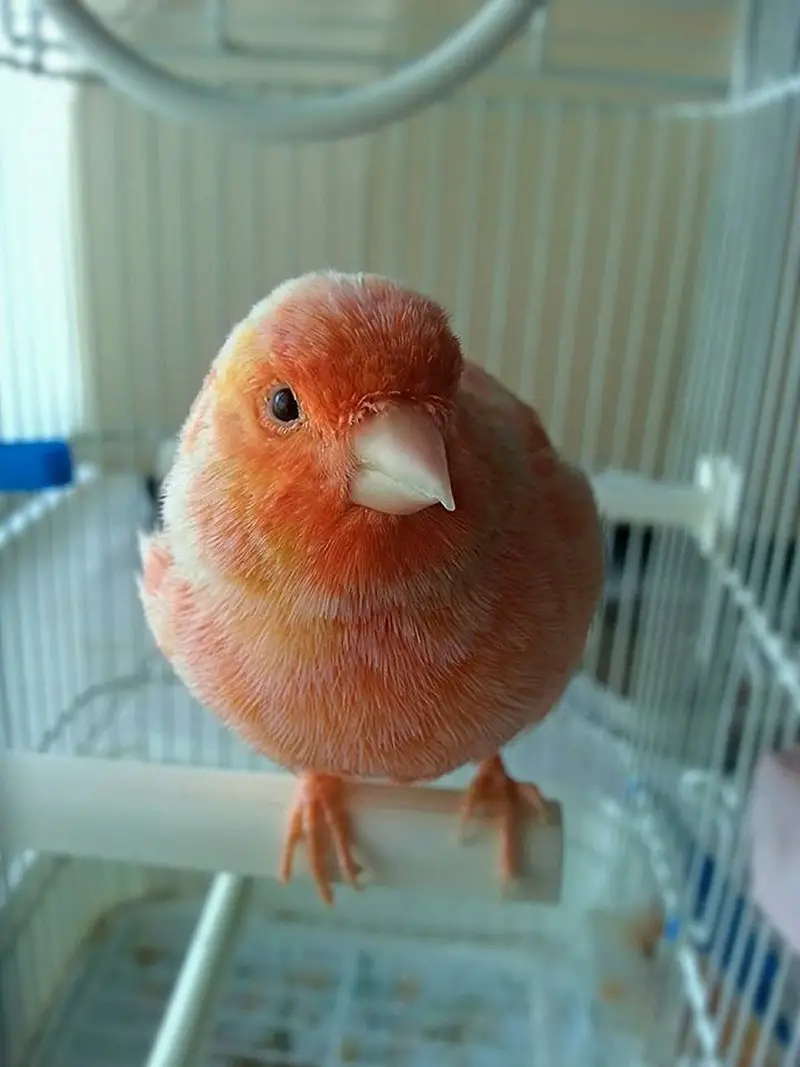
The domestic canary, also referred to as simply the canary, is a small finch originating from the Macaronesian Islands. It is a domesticated form of the wild canary, often kept as a pet due to its beautiful vocal abilities.
These birds were first bred in captivity in the 17th century and were brought to Europe by Spanish sailors.
Canaries are highly valued for their melodious songs and were once considered a luxury pet due to their high cost.
Despite their small size, they have a significant impact on the pet industry and are beloved by many bird enthusiasts worldwide.
Welcome in households as well as aviaries, canaries are a popular and charming addition to any home.Scientific classification:
| Kingdom | Animalia |
| Phylum | Chordata |
| Class | Aves |
| Order | Passeriformes |
| Family | Fringillidae |
| Subfamily | Carduelinae |
| Genus | Serinus |
| Species | S. canaria |
| Subspecies | S. c. domestica |
Also Featured In: Aviary Birds You Should Know, Case Birds that Live in with Us
51. Chicken
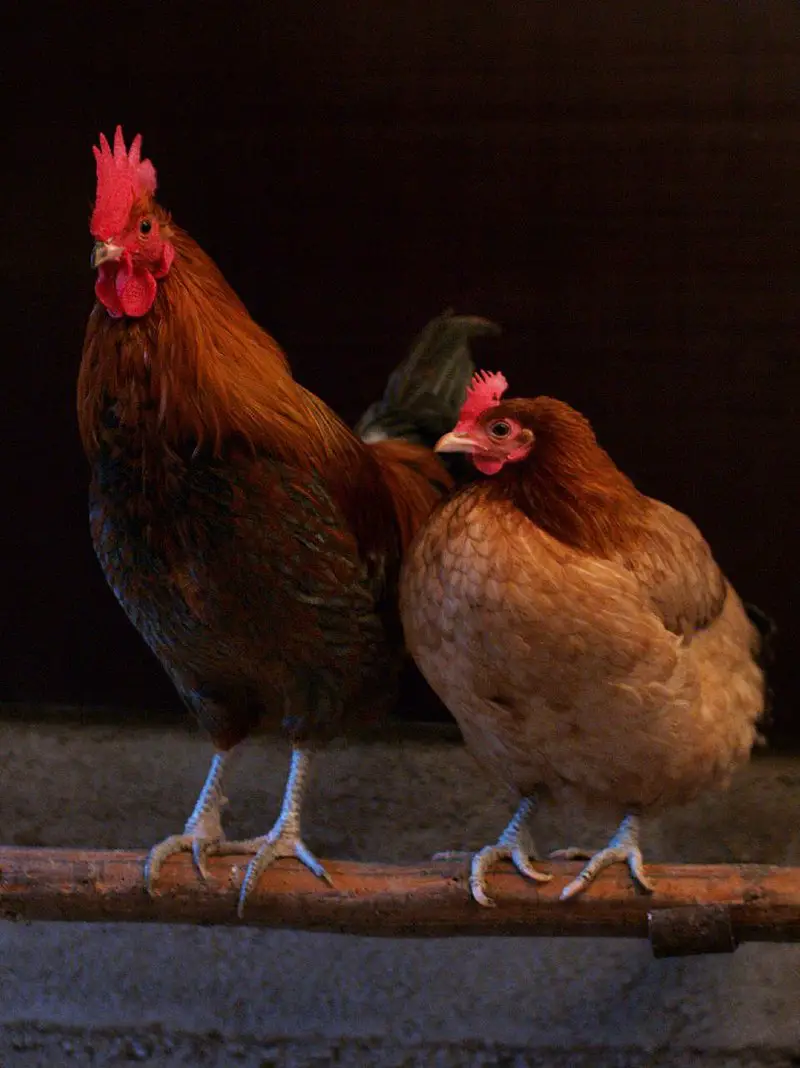
The chicken, a commonly domesticated species, originates from Southeast Asia and exhibits traits of wild grey and Ceylon junglefowl. Adult male birds are referred to as roosters or cocks, while a younger male is called a cockerel.
A castrated male is called a capon. Adult female chickens are known as hens, and sexually immature females are known as pullets.
Chickens are known for their ability to lay eggs and are often raised for meat consumption. They come in a variety of breeds and can have different colors and patterns on their feathers.
Chickens are also popular as pets and often require a coop or enclosure for proper care.Scientific classification:
| Kingdom | Animalia |
| Phylum | Chordata |
| Class | Aves |
| Order | Galliformes |
| Family | Phasianidae |
| Genus | Gallus |
| Species | G. gallus |
| Subspecies | G. g. domesticus |
Also Featured In: Asian Birds, Birds that are Used in Feng Shui